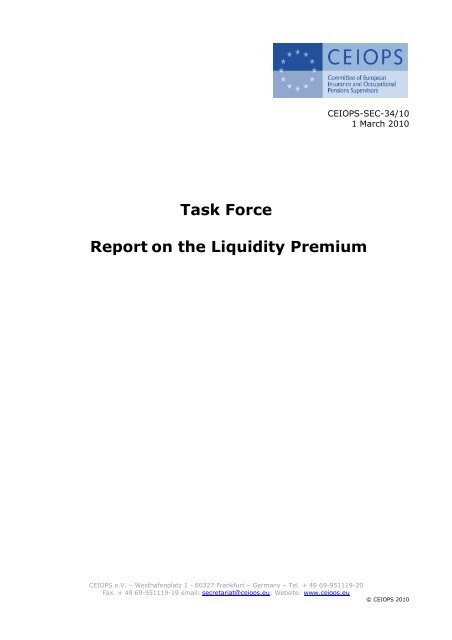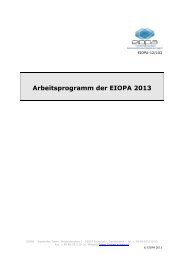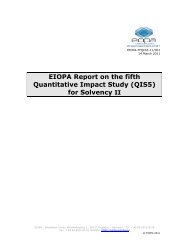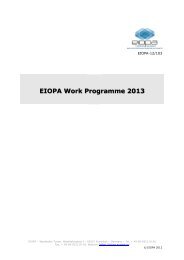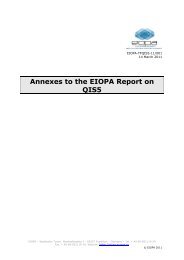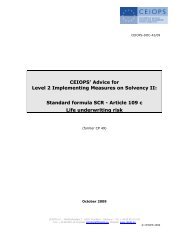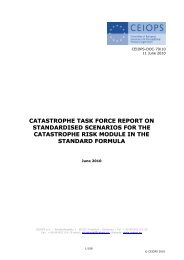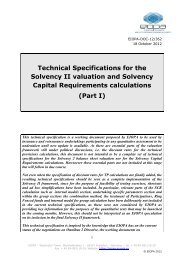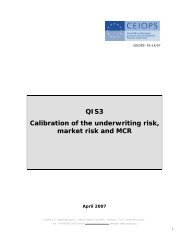CEIOPS Task Force Report on the Liquidity Premium - Eiopa
CEIOPS Task Force Report on the Liquidity Premium - Eiopa
CEIOPS Task Force Report on the Liquidity Premium - Eiopa
You also want an ePaper? Increase the reach of your titles
YUMPU automatically turns print PDFs into web optimized ePapers that Google loves.
<str<strong>on</strong>g>Task</str<strong>on</strong>g> <str<strong>on</strong>g>Force</str<strong>on</strong>g><br />
<str<strong>on</strong>g>Report</str<strong>on</strong>g> <strong>on</strong> <strong>the</strong> <strong>Liquidity</strong> <strong>Premium</strong><br />
<str<strong>on</strong>g>CEIOPS</str<strong>on</strong>g>-SEC-34/10<br />
1 March 2010<br />
<str<strong>on</strong>g>CEIOPS</str<strong>on</strong>g> e.V. – Westhafenplatz 1 - 60327 Frankfurt – Germany – Tel. + 49 69-951119-20<br />
Fax. + 49 69-951119-19 email: secretariat@ceiops.eu; Website: www.ceiops.eu<br />
© <str<strong>on</strong>g>CEIOPS</str<strong>on</strong>g> 2010
Summary<br />
Introducti<strong>on</strong>: mandate of <strong>the</strong> <str<strong>on</strong>g>Task</str<strong>on</strong>g> <str<strong>on</strong>g>Force</str<strong>on</strong>g><br />
Part I – <strong>Liquidity</strong> premium<br />
I - 1. Definiti<strong>on</strong> of liquidity of an insurance liability<br />
I - 2. Industry’s business case: why a liquidity premium<br />
I - 3. Risks and challenges<br />
I - 4. Principles underlying <strong>the</strong> use of liquidity premiums<br />
I - 5. Methods of calculati<strong>on</strong> of a liquidity premium for assets<br />
I - 6. Methods of calculati<strong>on</strong> of a liquidity premium for liabilities<br />
I - 7. Incidence <strong>on</strong> SCR and risk margin<br />
I - 8. Scope of applicati<strong>on</strong><br />
I - 9. Interplay with <strong>the</strong> choice of <strong>the</strong> basis risk free interest rate curve<br />
and with extrapolati<strong>on</strong><br />
Part II – Extrapolati<strong>on</strong><br />
II - 1. Principles for extrapolating <strong>the</strong> basic risk free interest rate term<br />
structure<br />
II - 2. Incidence <strong>on</strong> SCR<br />
II - 3. Interplay with choice of <strong>the</strong> basis risk free interest rate curve<br />
Part III – Choice of <strong>the</strong> basic risk free interest rate term structure<br />
Annex A – A possible proxy for <strong>the</strong> liquidity premium <strong>on</strong> assets<br />
Annex B - Comparis<strong>on</strong> of different methods for calculating <strong>the</strong> liquidity<br />
premium<br />
Annex C – Compositi<strong>on</strong> of <strong>the</strong> <str<strong>on</strong>g>Task</str<strong>on</strong>g> <str<strong>on</strong>g>Force</str<strong>on</strong>g><br />
2/33<br />
© <str<strong>on</strong>g>CEIOPS</str<strong>on</strong>g> 2010
INTRODUCTION<br />
On 29 October 2009 during its Members Meeting, <str<strong>on</strong>g>CEIOPS</str<strong>on</strong>g> has agreed to lead fur<strong>the</strong>r<br />
work <strong>on</strong> <strong>the</strong> issue of <strong>the</strong> inclusi<strong>on</strong> of a liquidity premium in <strong>the</strong> risk-free rate for<br />
discounting technical provisi<strong>on</strong>s as an additi<strong>on</strong>al input for Level 2 implementing<br />
measures.<br />
In order to carry out this work, a clear c<strong>on</strong>cept and mandate were needed and a <str<strong>on</strong>g>Task</str<strong>on</strong>g><br />
<str<strong>on</strong>g>Force</str<strong>on</strong>g> was created.<br />
The aim of <strong>the</strong> <str<strong>on</strong>g>Task</str<strong>on</strong>g> <str<strong>on</strong>g>Force</str<strong>on</strong>g> was to c<strong>on</strong>sider, from a technical point of view, <strong>the</strong><br />
implicati<strong>on</strong>s of allowing for a liquidity premium in order to provide Members with <strong>the</strong><br />
technical background informati<strong>on</strong> to advise <strong>the</strong> political level in this area. In doing so,<br />
<strong>the</strong> <str<strong>on</strong>g>Task</str<strong>on</strong>g> <str<strong>on</strong>g>Force</str<strong>on</strong>g> was to take into account c<strong>on</strong>siderati<strong>on</strong>s expressed in <str<strong>on</strong>g>CEIOPS</str<strong>on</strong>g>’ advice<br />
for Level 2 implementing measures and previous work d<strong>on</strong>e by stakeholders.<br />
<str<strong>on</strong>g>CEIOPS</str<strong>on</strong>g> invited stakeholders to join <strong>the</strong> <str<strong>on</strong>g>Task</str<strong>on</strong>g> <str<strong>on</strong>g>Force</str<strong>on</strong>g>. CRO/CFO Forum, CEA, Groupe<br />
C<strong>on</strong>sultatif, AMICE and Prof. Anto<strong>on</strong> Pelsser from Maastricht University were invited to<br />
discuss this issue with a small group of <str<strong>on</strong>g>CEIOPS</str<strong>on</strong>g> Members. Commissi<strong>on</strong> services were<br />
invited as observers to <strong>the</strong> discussi<strong>on</strong>s, too.<br />
The <str<strong>on</strong>g>Task</str<strong>on</strong>g> <str<strong>on</strong>g>Force</str<strong>on</strong>g> had also to c<strong>on</strong>sider <strong>the</strong> relati<strong>on</strong> of <strong>the</strong> liquidity premium with <strong>the</strong><br />
choice of <strong>the</strong> reference rate (government b<strong>on</strong>d rate and swap rate), developing <strong>the</strong><br />
adjustments needed for relevant instruments to achieve <strong>the</strong> criteria that have to be<br />
met in order to be c<strong>on</strong>sistent with a risk-free rate. Fur<strong>the</strong>rmore, <strong>the</strong> task force was<br />
commissi<strong>on</strong>ed to develop principles for determining appropriate extrapolati<strong>on</strong><br />
techniques for <strong>the</strong> interest rate curve.<br />
3/33<br />
© <str<strong>on</strong>g>CEIOPS</str<strong>on</strong>g> 2010
PART I – LIQUIDITY PREMIUM<br />
C<strong>on</strong>cerning <strong>the</strong> liquidity premium this chapter strives to give a definiti<strong>on</strong> of liquidity of<br />
insurance liabilities, explain <strong>the</strong> relevance of <strong>the</strong> issue, discuss shortcomings and<br />
challenges, examine possible methods of calculati<strong>on</strong> and define <strong>the</strong> possible scope of<br />
a liquidity premium.<br />
In particular answers are provided to <strong>the</strong> following questi<strong>on</strong>s raised in <strong>the</strong> mandate of<br />
<strong>the</strong> <str<strong>on</strong>g>Task</str<strong>on</strong>g> <str<strong>on</strong>g>Force</str<strong>on</strong>g>.<br />
• For which obligati<strong>on</strong>s and/or products <strong>the</strong> inclusi<strong>on</strong> of a liquidity premium<br />
could be allowed for. The characteristics of <strong>the</strong>se obligati<strong>on</strong>s and/or<br />
products will need to be defined (see chapter I-6)<br />
• What <strong>the</strong> implicati<strong>on</strong>s would be for a) policyholders, b) financial stability,<br />
and c) <strong>the</strong> investment policy of <strong>the</strong> undertaking (see chapter I-2)<br />
• Whe<strong>the</strong>r <strong>the</strong> use of a liquidity premium should be limited to business<br />
currently in force, or applied to existing and future business, including a<br />
transiti<strong>on</strong>al period of applicati<strong>on</strong> up<strong>on</strong> <strong>the</strong> introducti<strong>on</strong> of Solvency II,<br />
c<strong>on</strong>sidering implicati<strong>on</strong>s <strong>on</strong> markets. (see chapter I-8)<br />
• How to measure <strong>the</strong> liquidity premium and incorporate it into <strong>the</strong><br />
discount rate in an objective, reliable and c<strong>on</strong>sistent way in order to allow<br />
harm<strong>on</strong>ised implementati<strong>on</strong>. (see chapters I-5 and I-6)<br />
• How often should <strong>the</strong> liquidity premium be revised; (see chapter I-4<br />
principle # 5)<br />
• C<strong>on</strong>sequences of <strong>the</strong> inclusi<strong>on</strong> of <strong>the</strong> liquidity premium <strong>on</strong> <strong>the</strong> overall<br />
solvency positi<strong>on</strong>, in particular <strong>on</strong> <strong>the</strong> SCR standard formula, and whe<strong>the</strong>r<br />
any soluti<strong>on</strong>s proposed may necessitate changes to o<strong>the</strong>r parts of <str<strong>on</strong>g>CEIOPS</str<strong>on</strong>g>’<br />
final advice (see chapter I-7)<br />
I - 1. Definiti<strong>on</strong> of liquidity of an insurance liability<br />
For <strong>the</strong> holder of an asset like a corporate b<strong>on</strong>d, liquidity means <strong>the</strong> ability to sell or<br />
cash in this asset at any time at a price equal to <strong>the</strong> present value of future cash flows<br />
discounted at <strong>the</strong> risk free interest rate, but adjusted for expected credit risk and<br />
credit risk uncertainty (unexpected credit risk).<br />
Illiquidity occurs, for example, where <strong>the</strong> asset is not readily saleable due to<br />
uncertainty about its value or due to <strong>the</strong> lack of a market in which it is regularly<br />
traded.<br />
Where assets are illiquid, investors demand an additi<strong>on</strong>al premium as a reward for <strong>the</strong><br />
risk of incurring additi<strong>on</strong>al transacti<strong>on</strong> costs in case where <strong>the</strong> asset has to be sold.<br />
This additi<strong>on</strong>al premium leads to an increase in <strong>the</strong> implicit yield of <strong>the</strong> instrument,<br />
and hence in <strong>the</strong> spread over and above <strong>the</strong> liquid risk free rate.<br />
However, <strong>the</strong> liquidity premium is <strong>on</strong>ly <strong>on</strong>e comp<strong>on</strong>ent of <strong>the</strong> total spread between<br />
<strong>the</strong> yield of an asset and <strong>the</strong> liquid risk-free rate. This spread also includes a<br />
compensati<strong>on</strong> for o<strong>the</strong>r comp<strong>on</strong>ents such as expected credit risk, credit risk<br />
uncertainty (unexpected credit risk) and management expense risk. Fur<strong>the</strong>rmore, a<br />
4/33<br />
© <str<strong>on</strong>g>CEIOPS</str<strong>on</strong>g> 2010
"residual" element (due to e.g. taxes, c<strong>on</strong>versi<strong>on</strong> costs or costs of market<br />
imperfecti<strong>on</strong>s) remains. Thus, to determine <strong>the</strong> part of <strong>the</strong> spread attributable to<br />
liquidity risk, <strong>the</strong> challenge that has to be faced is <strong>the</strong> accurate breakdown of this<br />
spread into its comp<strong>on</strong>ents.<br />
Insofar as credit risk, both expected and unexpected, might ideally be eliminated<br />
through <strong>the</strong> use of a CDS, <strong>the</strong> part of <strong>the</strong> spread attributable to credit risk could be<br />
approximated by using <strong>the</strong> market value of <strong>the</strong> CDS as a reference. Such an<br />
approximati<strong>on</strong> should take into account that <strong>the</strong>re is repeated evidence that CDS<br />
markets are influenced by a lot of trends and features, in such a manner that a markto-model<br />
value of a <strong>the</strong>oretically risk free liquid asset is not necessarily <strong>the</strong> present<br />
value of future cash flows minus <strong>the</strong> market value of <strong>the</strong> CDS. Due c<strong>on</strong>siderati<strong>on</strong><br />
should also be given to <strong>the</strong> credit risks associated with <strong>the</strong> CDS providers.<br />
In <strong>the</strong> case of an asset represented by a claim <strong>on</strong> an insurance company, in many<br />
cases <strong>the</strong> policyholder may be unable to sell this asset in <strong>the</strong> absence of a market or<br />
his ability to cash in <strong>the</strong> policy value may be limited by legal or c<strong>on</strong>tractual c<strong>on</strong>straints<br />
or by financial penalties. Although such insurance claims present clear illiquidity<br />
characteristics, it is not possible to measure directly <strong>the</strong> attached liquidity premium as<br />
for corporate b<strong>on</strong>ds.<br />
A majority of TF members believe n<strong>on</strong>e<strong>the</strong>less that a liquidity premium for insurance<br />
liabilities can be estimated through <strong>the</strong> use of a replicating portfolio of assets.<br />
Unlike corporate b<strong>on</strong>ds, insurance liabilities represent a full range of cash flow<br />
characteristics with varying levels of uncertainty due e.g. to policyholder opti<strong>on</strong>s such<br />
as surrenders, withdrawals, etc. or to mortality and expenses evoluti<strong>on</strong>. These<br />
characteristics of an insurance liability have as a c<strong>on</strong>sequence that in some cases no<br />
replicating portfolio can accurately match <strong>the</strong> cash flows of <strong>the</strong> liability in all<br />
circumstances or <strong>the</strong> replicating portfolio has to c<strong>on</strong>tain a combinati<strong>on</strong> of both liquid<br />
and illiquid assets.<br />
The above menti<strong>on</strong>ed majority of TF members c<strong>on</strong>sider that <strong>the</strong> illiquidity of an<br />
insurance liability measures thus <strong>the</strong> extent up to which its cash flows are predictable,<br />
i.e. are certain in amount and in timing.<br />
They recognize that this assessment is very complex, given <strong>the</strong> numerous and<br />
complex features involved, and also c<strong>on</strong>sidering that a number of those features have<br />
a behaviour difficult to model in a reliable manner (e.g. policyholders’ behaviour in<br />
different scenarios). It has to be noted however that <strong>the</strong> assessment of <strong>the</strong><br />
predictability of <strong>the</strong> cash flows of an insurance liability is already required for <strong>the</strong><br />
valuati<strong>on</strong> of any embedded financial opti<strong>on</strong>s and guarantees, such as surrender<br />
opti<strong>on</strong>s, and that cash flows will be subject to <strong>the</strong> same policyholder behaviour<br />
assumpti<strong>on</strong>s for <strong>the</strong> valuati<strong>on</strong> of both embedded opti<strong>on</strong>s and guarantees and liquidity<br />
premium.<br />
A minority of TF members c<strong>on</strong>sider that <strong>the</strong>re is insufficient evidence that any<br />
illiquidity feature regarding insurance liabilities will behave in <strong>the</strong> same manner as for<br />
assets. They c<strong>on</strong>sider likely that a liquidity premium associated to insurance liabilities<br />
may present substantially different features than any liquidity premium eventually<br />
derived for assets by using market observati<strong>on</strong>s and applying <strong>the</strong>oretical models.<br />
They assume that liquidity is, <strong>on</strong>ly to a certain extent, linked to predictability of cash<br />
flows, both c<strong>on</strong>cepts being different in <strong>the</strong>ir substance and <strong>the</strong>ir c<strong>on</strong>sequences and<br />
5/33<br />
© <str<strong>on</strong>g>CEIOPS</str<strong>on</strong>g> 2010
<strong>the</strong>y advocate some cauti<strong>on</strong> to <strong>the</strong> extent that predictability is not always meaning<br />
liquidity and vice versa.<br />
These TF members never<strong>the</strong>less accept <strong>the</strong> criteria based <strong>on</strong> <strong>the</strong> degree of<br />
predictability of cash flows, not <strong>on</strong> <strong>the</strong> ground of a <strong>the</strong>oretically sound approach to<br />
liquidity, but merely as a practical way to reach c<strong>on</strong>sensus.<br />
If despite <strong>the</strong> above reservati<strong>on</strong>s a c<strong>on</strong>sensus is reached to define <strong>the</strong> liquidity of an<br />
insurance liability by reference to predictability of cash flows, it follows that this<br />
liquidity is not a binary c<strong>on</strong>cept, but a c<strong>on</strong>tinuous property with <strong>on</strong> <strong>on</strong>e side of <strong>the</strong><br />
spectrum liabilities where <strong>the</strong> legal and c<strong>on</strong>tractual features of <strong>the</strong> liability do not<br />
allow for policyholder opti<strong>on</strong>s impacting <strong>the</strong> certainty of future cash flows and where<br />
residual uncertainty of future cash flows is not material with regard to <strong>the</strong> cash flows<br />
of a replicating portfolio, and <strong>on</strong> <strong>the</strong> opposite end liabilities where <strong>the</strong> cash outflows<br />
are not restricted and are highly volatile 1 .<br />
Assessing <strong>the</strong> uncertainty of future cash flows may be <strong>the</strong> more challenging as <strong>the</strong><br />
predictability of different cash flows within <strong>the</strong> same c<strong>on</strong>tract may vary over time (e.g.<br />
c<strong>on</strong>tracts not granting surrender right within a period or under certain c<strong>on</strong>diti<strong>on</strong>s, but<br />
granting such right in o<strong>the</strong>r periods or circumstances) or may depend <strong>on</strong> different<br />
features difficult to prioritise (i.e. comparing two c<strong>on</strong>tracts where <strong>on</strong>e may be more<br />
liquid analyzing some features but less liquid from some o<strong>the</strong>r perspective).<br />
In assessing this uncertainty, due c<strong>on</strong>siderati<strong>on</strong> has to be given to resilience to forced<br />
sales (i.e. <strong>the</strong> possibility to pass <strong>on</strong> <strong>the</strong> loss of any liquidity premium arising from<br />
forced sales to policyholders).<br />
It has to be noted that while acknowledging that liquidity is a c<strong>on</strong>tinuous property of<br />
an insurance liability, this does not mean that a liquidity premium should<br />
automatically be used for liabilities which are <strong>on</strong>ly partially illiquid. Indeed applying a<br />
liquidity premium to liabilities which are <strong>on</strong>ly partially illiquid in an objective and<br />
reliable manner may be a challenging exercise and avoidance of arbitrary decisi<strong>on</strong>s<br />
and unlevel playing field range high am<strong>on</strong>g <strong>the</strong> c<strong>on</strong>cerns expressed by supervisors.<br />
C<strong>on</strong>clusi<strong>on</strong>s<br />
The illiquidity of an insurance liability measures <strong>the</strong> extent up to which its<br />
cash flows are certain in amount and in timing due c<strong>on</strong>siderati<strong>on</strong> being given<br />
to <strong>the</strong> resilience to forced sales.<br />
Most life insurance liabilities can be c<strong>on</strong>sidered to be at least partially<br />
illiquid.<br />
A prerequisite for <strong>the</strong> applicati<strong>on</strong> of a liquidity premium to illiquid liabilities is<br />
<strong>the</strong> existence of objective and reliable methods allowing to measure <strong>the</strong><br />
degree of illiquidity.<br />
1 While it is often c<strong>on</strong>sidered that annuities in force could be ranged in <strong>the</strong> first category, it is still possible to have<br />
reas<strong>on</strong>able predicti<strong>on</strong>s for cash flows for most o<strong>the</strong>r life insurance liabilities and <strong>the</strong>se liabilities could thus be<br />
c<strong>on</strong>sidered to be at least partially illiquid.<br />
6/33<br />
© <str<strong>on</strong>g>CEIOPS</str<strong>on</strong>g> 2010
I - 2. Industry’s business case: why a liquidity premium<br />
Although a large body of ec<strong>on</strong>omic <strong>the</strong>ory <strong>on</strong> liquidity premiums has existed for many<br />
years, <strong>the</strong> breakdown into its different comp<strong>on</strong>ents of <strong>the</strong> spreads of corporate b<strong>on</strong>ds<br />
versus government b<strong>on</strong>ds and swap rates did not capture general attenti<strong>on</strong> by <strong>the</strong><br />
insurance industry, but was treated by some market participants <strong>on</strong> a more individual<br />
basis. Companies used analysis by organisati<strong>on</strong>s such as Moodys to remove <strong>the</strong><br />
expected credit risk porti<strong>on</strong> of b<strong>on</strong>d spreads. The balance, split between credit risk<br />
uncertainty (unexpected credit risk) and illiquidity, received less attenti<strong>on</strong>. An analysis<br />
of <strong>the</strong> pricing of credit default swaps and o<strong>the</strong>r credit risk mitigating instruments<br />
c<strong>on</strong>firms that up to <strong>the</strong> spring of 2008 <strong>the</strong> bulk of <strong>the</strong> spread could be allocated to<br />
credit risk, both expected and unexpected.<br />
Things changed radically in 2008 where, even ahead of <strong>the</strong> crisis, spreads increased<br />
sharply, leading to new research work being undertaken by <strong>the</strong> insurance industry <strong>on</strong><br />
<strong>the</strong> decompositi<strong>on</strong> of <strong>the</strong>se spreads. Fur<strong>the</strong>r substantial increases in spreads followed<br />
in September and October. Research work evidenced that by end of 2008 spreads<br />
exceeded by far <strong>the</strong> cost of credit risk mitigati<strong>on</strong> and included a new comp<strong>on</strong>ent which<br />
was much less visible in <strong>the</strong> years before.<br />
In line with <strong>the</strong> pre-existing <strong>the</strong>oretical work industry c<strong>on</strong>cludes that <strong>the</strong> new wider<br />
b<strong>on</strong>d spreads are attributable, at least to a certain extent, to <strong>the</strong> existence of a<br />
liquidity premium, compensating <strong>the</strong> investor in corporate b<strong>on</strong>ds for <strong>the</strong> risk of not<br />
being able to get, by selling <strong>the</strong> instrument, a revenue at any time which corresp<strong>on</strong>ds<br />
to <strong>the</strong> future cash flows. This analysis seems to be c<strong>on</strong>firmed by <strong>the</strong> fact that <strong>the</strong> new<br />
comp<strong>on</strong>ent reached a peak in late 2008 where corporate b<strong>on</strong>d markets experienced a<br />
marked lack of liquidity. This peak persisted through March 2009 since when it has<br />
declined slowly.<br />
The c<strong>on</strong>sequence of <strong>the</strong> sudden increase of spreads due to illiquidity was a sharp<br />
decline in <strong>the</strong> value of corporate b<strong>on</strong>d portfolios of insurance companies. Even in<br />
cases where <strong>the</strong>se portfolios were hedged against default risk of <strong>the</strong> corresp<strong>on</strong>ding<br />
issuers, <strong>the</strong> increase in value of <strong>the</strong> hedge instruments was insufficient to compensate<br />
for <strong>the</strong> devaluati<strong>on</strong> of <strong>the</strong> b<strong>on</strong>d portfolio.<br />
<str<strong>on</strong>g>CEIOPS</str<strong>on</strong>g> members of <strong>the</strong> task <str<strong>on</strong>g>Force</str<strong>on</strong>g> generally accept <strong>the</strong> existence of a liquidity<br />
premium <strong>on</strong> <strong>the</strong> asset side. It is worthwhile menti<strong>on</strong>ing that this positi<strong>on</strong> is in line with<br />
<strong>the</strong> final advice delivered by <str<strong>on</strong>g>CEIOPS</str<strong>on</strong>g> <strong>on</strong> <strong>the</strong> spread risk calibrati<strong>on</strong>. Whereas <strong>the</strong><br />
capital charge was initially calibrated taking into account total return indices <strong>on</strong><br />
corporate b<strong>on</strong>ds <strong>the</strong> final advice uses CDS spreads, thus acknowledging that part of<br />
observed spreads <strong>on</strong> corporate b<strong>on</strong>ds are not attributable to credit risk.<br />
On <strong>the</strong> liability side <strong>the</strong> value of insurance liabilities was left unchanged, even where<br />
<strong>the</strong>se liabilities were almost entirely illiquid <strong>on</strong> a permanent basis, and not <strong>on</strong>ly during<br />
<strong>the</strong> crisis of late 2008.<br />
It is comm<strong>on</strong> practise to cover illiquid insurance liabilities with highly predictable cash<br />
flows with similarly potentially illiquid assets with corresp<strong>on</strong>ding maturities – <strong>the</strong><br />
alternative to such an approach would be an increase in <strong>the</strong> price of products for<br />
c<strong>on</strong>sumers. The appearance of an important liquidity premium implicitly c<strong>on</strong>tained in<br />
<strong>the</strong> valuati<strong>on</strong> of <strong>the</strong>se assets created a shortfall in <strong>the</strong> balance sheet of <strong>the</strong> c<strong>on</strong>cerned<br />
companies and <strong>the</strong> insurance industry claims this shortfall to be artificial insofar that<br />
7/33<br />
© <str<strong>on</strong>g>CEIOPS</str<strong>on</strong>g> 2010
in case of an efficient hedge against credit risk, <strong>the</strong> revenues of <strong>the</strong> assets, both<br />
regular and at maturity, were not at risk and were sufficient to match <strong>the</strong> cash<br />
outflows of <strong>the</strong> insurance c<strong>on</strong>tracts.<br />
The introducti<strong>on</strong> of a liquidity premium in <strong>the</strong> valuati<strong>on</strong> of insurance liabilities aims at<br />
eliminating this valuati<strong>on</strong> mismatch and avoiding <strong>the</strong> situati<strong>on</strong> that such investments<br />
no l<strong>on</strong>ger become an opti<strong>on</strong> for companies with a detrimental impact <strong>on</strong> both<br />
c<strong>on</strong>sumers and financial markets.<br />
Although eliminati<strong>on</strong> of pro-cyclicality is not <strong>the</strong> main objective of a liquidity premium,<br />
<strong>the</strong> introducti<strong>on</strong> of such a premium is certainly beneficial in this respect as it prevents<br />
corporate b<strong>on</strong>d holders wishing to mitigate <strong>the</strong> shortfall menti<strong>on</strong>ed above, from selling<br />
<strong>the</strong>ir b<strong>on</strong>d portfolios in times of stressed liquidity, thus aggravating <strong>the</strong> overall crisis.<br />
In this regard, setting in <strong>the</strong> Solvency II regime a prudent and transparent<br />
mechanism for <strong>the</strong> additi<strong>on</strong> of a liquidity premium would provide a coherent<br />
framework for an harm<strong>on</strong>ized treatment of distressed market c<strong>on</strong>diti<strong>on</strong>s across EU<br />
jurisdicti<strong>on</strong>s and, at <strong>the</strong> same time, would introduce <strong>the</strong> regulatory certainty which is<br />
a prec<strong>on</strong>diti<strong>on</strong> for allowing insurance undertaking to invest in l<strong>on</strong>g term assets.<br />
The insurance industry c<strong>on</strong>cludes from <strong>the</strong> above analysis that <strong>the</strong> additi<strong>on</strong> of a<br />
liquidity premium for <strong>the</strong> valuati<strong>on</strong> of illiquid liabilities is justified, but adds that such<br />
an additi<strong>on</strong> would <strong>on</strong>ly occur to a significant extent during <strong>the</strong> infrequent periods<br />
where a similar premium can be identified <strong>on</strong> <strong>the</strong> asset side.<br />
While it is <strong>the</strong> case that many insurance liabilities are illiquid <strong>on</strong> a permanent basis,<br />
<strong>the</strong> industry accepts that this does not result in a permanent level of a significant<br />
liquidity premium. In periods where <strong>the</strong> additi<strong>on</strong>al price asked by markets in<br />
compensati<strong>on</strong> for illiquidity is low <strong>on</strong> <strong>the</strong> asset side, it seems logical that a similar low<br />
credit for illiquidity should be granted <strong>on</strong> <strong>the</strong> liabilities side of <strong>the</strong> balance sheet as<br />
well.<br />
C<strong>on</strong>clusi<strong>on</strong>s:<br />
As a c<strong>on</strong>clusi<strong>on</strong> of its work <strong>on</strong> decompositi<strong>on</strong> of spreads of corporate b<strong>on</strong>ds<br />
versus government b<strong>on</strong>ds and swap rates, <strong>the</strong> insurance industry c<strong>on</strong>cludes<br />
that:<br />
a) In normal circumstances <strong>the</strong> liquidity premium <strong>on</strong> assets is small and<br />
has thus no significant influence <strong>on</strong> <strong>the</strong> valuati<strong>on</strong> of insurance<br />
liabilities.<br />
b) During periods of stressed liquidity <strong>the</strong> liquidity premium <strong>on</strong> assets has<br />
a positive value, but its applicati<strong>on</strong> to insurance liabilities aims <strong>on</strong>ly to<br />
eliminate an valuati<strong>on</strong> mismatch between <strong>the</strong> valuati<strong>on</strong> of assets and<br />
liabilities.<br />
c) Although it is not its main objective, <strong>the</strong> liquidity premium has an anticyclical<br />
effect and allows a harm<strong>on</strong>ized treatment of distressed market<br />
c<strong>on</strong>diti<strong>on</strong>s.<br />
8/33<br />
© <str<strong>on</strong>g>CEIOPS</str<strong>on</strong>g> 2010
I - 3. Alternatives, risks and challenges<br />
Doubts have been expressed as to <strong>the</strong> compatibility of <strong>the</strong> inclusi<strong>on</strong> of a liquidity<br />
premium in <strong>the</strong> calculati<strong>on</strong> of liabilities with <strong>the</strong> Level 1 text 2 . The EC representative<br />
c<strong>on</strong>firms however that <strong>the</strong> noti<strong>on</strong> of relevant risk free rate allows for <strong>the</strong> additi<strong>on</strong> of a<br />
liquidity premium insofar this premium may be earned by insurance undertakings<br />
without incurring credit risk.<br />
The <str<strong>on</strong>g>Task</str<strong>on</strong>g> <str<strong>on</strong>g>Force</str<strong>on</strong>g> has fur<strong>the</strong>r examined whe<strong>the</strong>r <strong>the</strong> mismatch referred to in <strong>the</strong><br />
industry’s business case could not be avoided by an alternative soluti<strong>on</strong> c<strong>on</strong>sisting in<br />
times of stressed liquidity in a valuati<strong>on</strong> of illiquid assets with mark-to-model<br />
approaches providing values that represent <strong>the</strong> ec<strong>on</strong>omic revenues of <strong>the</strong> assets, both<br />
regular and at maturity.<br />
Although during <strong>the</strong> last crisis market values still existed for many stressed assets, it<br />
could be argued that <strong>the</strong>se market values no l<strong>on</strong>ger relied <strong>on</strong> deep, liquid and<br />
transparent markets and that thus <strong>the</strong> level 1 Directive would have allowed mark-tomodel<br />
approaches. Under <strong>the</strong> alternative approach stressed c<strong>on</strong>diti<strong>on</strong>s in <strong>the</strong> markets<br />
for <strong>the</strong> underlying asset prices would be reflected by an adjustment to asset prices<br />
ra<strong>the</strong>r than to <strong>the</strong> value of liabilities. If <strong>the</strong> aforementi<strong>on</strong>ed stress is due to illiquidity<br />
of markets this adjustment could be referred to as a liquidity premium.<br />
An important advantage of this alternative approach is that it is a so-called total<br />
balance sheet approach: all assets and liabilities are based <strong>on</strong> market prices, but <strong>the</strong>ir<br />
values are adjusted when <strong>the</strong>ir quoted market prices are no l<strong>on</strong>ger established in<br />
deep, liquid and transparent markets. This makes sense ec<strong>on</strong>omically, because in<br />
such circumstances <strong>the</strong> quoted market prices are biased and do not represent<br />
ec<strong>on</strong>omically relevant valuati<strong>on</strong> inputs.<br />
The liquidity premium proposal from industry’s business case in <strong>the</strong> previous chapter<br />
adjusts <strong>the</strong> value of liabilities for disturbances in <strong>the</strong> value of <strong>the</strong> assets. The<br />
alternative approach would allow an adjustment to <strong>the</strong> value of <strong>the</strong> liabilities <strong>on</strong>ly if<br />
<strong>the</strong>re are disturbances relevant to <strong>the</strong> valuati<strong>on</strong> of <strong>the</strong> liabilities. In case of<br />
disturbances relevant to <strong>the</strong> valuati<strong>on</strong> of assets, irrelevant market inputs to calculate<br />
<strong>the</strong> market values of assets should be treated <strong>on</strong> <strong>the</strong> asset side of <strong>the</strong> balance sheet.<br />
In that situati<strong>on</strong> <strong>the</strong> discounting rate (risk-free) should not be affected.<br />
In both cases of adjustments mark-to modelling should be carried out in line with<br />
procedures aligned with internati<strong>on</strong>al accounting standards. So both procedures<br />
should be linked to <strong>the</strong> market c<strong>on</strong>sistent valuati<strong>on</strong> of assets <strong>on</strong> <strong>the</strong> <strong>on</strong>e hand and of<br />
liabilities <strong>on</strong> <strong>the</strong> o<strong>the</strong>r hand and should <strong>the</strong>refore independent from <strong>the</strong> investment<br />
strategy adopted by <strong>the</strong> insurance undertaking.<br />
Providing a single mark-to-model value would however increase <strong>the</strong> value of illiquid<br />
assets even for those insurers not holding illiquid liabilities and incurring <strong>the</strong> risk of<br />
having to sell <strong>the</strong> assets at a price inferior to <strong>the</strong> <strong>on</strong>e used for solvency purposes and<br />
would thus introduce ano<strong>the</strong>r possible mismatch in <strong>the</strong> balance sheet. This requires<br />
additi<strong>on</strong>al treatment, in creating an additi<strong>on</strong>al layer to <strong>the</strong> liquidity premium formula<br />
or in creating a special SCR charge for this mismatch. Anyway this would not lead to<br />
less complexity and would necessitate calculati<strong>on</strong>s very similar to <strong>the</strong> <strong>on</strong>es proposed<br />
by industry.<br />
2 Especially article 77.2 of <strong>the</strong> Directive 2009/138/EC is meant here which states that “<strong>the</strong> best estimate shall<br />
corresp<strong>on</strong>d to <strong>the</strong> probability-weighted average of future cash-flows, taking account of <strong>the</strong> time value of m<strong>on</strong>ey, using<br />
<strong>the</strong> relevant risk-free interest rate term structure.”<br />
9/33<br />
© <str<strong>on</strong>g>CEIOPS</str<strong>on</strong>g> 2010
Despite <strong>the</strong> support of <strong>on</strong>e member and <strong>the</strong> willingness of o<strong>the</strong>rs members to fur<strong>the</strong>r<br />
explore this possibility, <strong>the</strong> <str<strong>on</strong>g>Task</str<strong>on</strong>g> <str<strong>on</strong>g>Force</str<strong>on</strong>g> has not fur<strong>the</strong>r c<strong>on</strong>sidered this alternative<br />
approach.<br />
In any case it needs to be ensured that <strong>the</strong> measurement of illiquidity is c<strong>on</strong>sistent<br />
with <strong>the</strong> solvency valuati<strong>on</strong> of assets. Under <strong>the</strong> Solvency II Framework, <strong>the</strong> valuati<strong>on</strong><br />
of assets shall generally be carried out in c<strong>on</strong>formity with internati<strong>on</strong>al accounting<br />
standards. Whereas <strong>the</strong> use of quoted market prices in active markets is envisaged to<br />
be <strong>the</strong> default valuati<strong>on</strong> approach, this will require regularly and readily available<br />
market prices that are observable in deep, liquid and transparent markets. However,<br />
for illiquid assets or markets (which are in <strong>the</strong> focus when liquidity premia are<br />
c<strong>on</strong>sidered) o<strong>the</strong>r valuati<strong>on</strong> techniques (mark to model) may have to be used. Such<br />
mark-to-model valuati<strong>on</strong>s are based <strong>on</strong> <strong>the</strong> modelling of cash flows expected to arise<br />
from <strong>the</strong> asset and may not coincide with observed market prices. In view of this,<br />
<str<strong>on</strong>g>CEIOPS</str<strong>on</strong>g> has already stressed <strong>the</strong> need to develop more guidance <strong>on</strong> <strong>the</strong> solvency<br />
valuati<strong>on</strong> in illiquid markets, including criteria for stressed sales, how to determine <strong>the</strong><br />
solvency “fair value” within <strong>the</strong> bid-ask spread and how to assess <strong>the</strong> liquidity<br />
premium when markets are inactive.<br />
Before this background, where a liquidity premium is determined it is necessary to<br />
ensure that such measurement is c<strong>on</strong>sistent with <strong>the</strong> solvency “fair value” valuati<strong>on</strong> of<br />
assets to avoid any double-counting which may arise if such measurement would <strong>on</strong>ly<br />
be based <strong>on</strong> observable market prices. Principle #6 included in chapter I – 4 recalls<br />
this important issue.<br />
With <strong>the</strong> excepti<strong>on</strong> of a <strong>the</strong>oretical model based <strong>on</strong> <strong>the</strong> work of Mert<strong>on</strong> (cf. structural<br />
model described in chapter 1-6), <strong>the</strong> two o<strong>the</strong>r methods based <strong>on</strong> market<br />
observati<strong>on</strong>s have <strong>on</strong>ly been developed recently and are still not fully stabilised. Due<br />
to <strong>the</strong> reliance <strong>on</strong> <strong>the</strong> values of innovative financial hedging instruments (CDS time<br />
series), <strong>the</strong> data series which can be used cover <strong>on</strong>ly a short time span. However this<br />
does not imply that <strong>the</strong> liquidity premium was not present in previous periods of high<br />
credit spreads.<br />
Even if it can be argued that <strong>the</strong> liquidity crisis experienced in 2008-2009 is a <strong>on</strong>e in<br />
two hundred years event, doubts remain whe<strong>the</strong>r methods and data series offer a<br />
sufficient degree of reliability. If calibrati<strong>on</strong> of a liquidity premium based <strong>on</strong> <strong>on</strong>ly few<br />
data points will already prove difficult, even more challenges will arise when it comes<br />
to <strong>the</strong> calculati<strong>on</strong> of <strong>the</strong> SCR. What will be <strong>the</strong> upward or downward shock of <strong>the</strong><br />
liquidity premium to be used in <strong>the</strong> calculati<strong>on</strong> of technical provisi<strong>on</strong>s corresp<strong>on</strong>ding<br />
99,5% probability? The argument of limited availability of data points however also<br />
holds for o<strong>the</strong>r parts of <strong>the</strong> calculati<strong>on</strong> of <strong>the</strong> SCR, such as for shocks applied to<br />
structured credit used in <strong>the</strong> credit spread SCR.<br />
Doubts have also been expressed whe<strong>the</strong>r illiquidity - while being plausible - is <strong>the</strong><br />
<strong>on</strong>ly possible explanati<strong>on</strong> of <strong>the</strong> new spread comp<strong>on</strong>ent observed during <strong>the</strong> financial<br />
crisis. If o<strong>the</strong>r factors intervene, how is it possible to determine reliably <strong>the</strong> liquidity<br />
part of <strong>the</strong> spread ?<br />
Supposing that all <strong>the</strong>se problems were solved, <strong>the</strong> additi<strong>on</strong> of a liquidity premium<br />
adds an additi<strong>on</strong>al layer of complexity to a solvency framework already criticised in<br />
this respect.<br />
10/33<br />
© <str<strong>on</strong>g>CEIOPS</str<strong>on</strong>g> 2010
Finally while resolving a valuati<strong>on</strong> mismatch issue for some insurers, <strong>the</strong> introducti<strong>on</strong><br />
of a liquidity premium for <strong>the</strong> valuati<strong>on</strong> of illiquid liabilities will introduce a new<br />
artificial mismatch for o<strong>the</strong>r insurers: this will be <strong>the</strong> case where no illiquid assets will<br />
be held for <strong>the</strong> coverage of <strong>the</strong> illiquid liabilities.<br />
I - 4. Principles underlying <strong>the</strong> use of liquidity premiums<br />
This secti<strong>on</strong> lays out a number of principles-based requirements which should be met<br />
in case a liquidity premium is allowed for in <strong>the</strong> valuati<strong>on</strong> of technical provisi<strong>on</strong>s.<br />
By setting out <strong>the</strong>se principles, it is not intended to pre-empt a decisi<strong>on</strong> <strong>on</strong> whe<strong>the</strong>r or<br />
not (and if so, to what extent) such an allowance should be made. A minority of task<br />
force members, representing a majority of <str<strong>on</strong>g>CEIOPS</str<strong>on</strong>g> <str<strong>on</strong>g>Task</str<strong>on</strong>g> <str<strong>on</strong>g>Force</str<strong>on</strong>g> members, c<strong>on</strong>sider that<br />
<strong>the</strong>re is a lack of <strong>the</strong>oretically sound, reliable and appropriately back-tested methods<br />
which could be used in practice to include a liquidity premium in <strong>the</strong> discount rate of<br />
cash flows arising from insurance liabilities based <strong>on</strong> <strong>the</strong> degree of liquidity of <strong>the</strong>se<br />
liabilities c<strong>on</strong>sistently with <strong>the</strong> principles set out below.<br />
Where an allowance for a “liquidity premium” in <strong>the</strong> determinati<strong>on</strong> of risk free interest<br />
rates is made, this should be also compatible with <strong>the</strong> criteria of absence of credit<br />
risk, realism, reliability, high liquidity and absence of technical bias as stated in<br />
<str<strong>on</strong>g>CEIOPS</str<strong>on</strong>g> advice <strong>on</strong> <strong>the</strong> risk free interest rate term structure and <strong>the</strong> principles-based<br />
requirements laid out below.<br />
It is proposed that <strong>the</strong> following 9 principles should apply to <strong>the</strong> use of liquidity<br />
premiums.<br />
#1. The risk free reference rate applicable to <strong>the</strong> valuati<strong>on</strong> of a liability<br />
should be <strong>the</strong> sum of a basic risk free reference rate and a liquidity premium<br />
depending <strong>on</strong> <strong>the</strong> nature of <strong>the</strong> liability.<br />
#2. The liquidity premium should be independent of <strong>the</strong> investment strategy<br />
adopted by <strong>the</strong> company.<br />
#3. The liquidity premium applicable to a liability should not exceed <strong>the</strong> extra<br />
return which can be earned by <strong>the</strong> insurer by holding illiquid assets free of<br />
credit risk, available in <strong>the</strong> financial markets and matching <strong>the</strong> cash flows of<br />
<strong>the</strong> liability.<br />
#4. The liquidity premium applicable to a liability should depend <strong>on</strong> <strong>the</strong><br />
nature of <strong>the</strong> liabilities having regard to <strong>the</strong> currency, <strong>the</strong> predictability of<br />
<strong>the</strong>ir cash flows (e.g. <strong>the</strong> ability to cash back/withdraw/surrender) and <strong>the</strong><br />
resilience to forced sales of illiquid assets covering technical liabilities (e.g.<br />
where any loss of liquidity premium can be transferred to policyholders).<br />
#5. The liquidity premium should be calculated and published by a central EU<br />
instituti<strong>on</strong> with <strong>the</strong> same frequency and according to <strong>the</strong> same procedures as<br />
<strong>the</strong> basic risk free interest rate.<br />
#6. The liquidity premium should be assessed and quantified by reliable<br />
methods based <strong>on</strong> objective market data from <strong>the</strong> relevant financial markets<br />
and c<strong>on</strong>sistent with solvency valuati<strong>on</strong> methods.<br />
11/33<br />
© <str<strong>on</strong>g>CEIOPS</str<strong>on</strong>g> 2010
#7. No liquidity premium should be applied to liabilities in <strong>the</strong> absence of a<br />
corresp<strong>on</strong>ding liquidity premium evidenced in <strong>the</strong> valuati<strong>on</strong> of assets.<br />
#8. The design and calibrati<strong>on</strong> of <strong>the</strong> SCR standard formula should ensure<br />
that its calculati<strong>on</strong> is c<strong>on</strong>sistent with a recogniti<strong>on</strong> of a liquidity premium in<br />
<strong>the</strong> valuati<strong>on</strong> of liabilities and compatible with <strong>the</strong> set Solvency II target<br />
criteria for solvency assessment. The calculati<strong>on</strong> of <strong>the</strong> SCR with internal<br />
models should also include an appropriate recogniti<strong>on</strong> of <strong>the</strong> risk arising from<br />
<strong>the</strong> liquidity premium in order to guarantee <strong>the</strong> targeted c<strong>on</strong>fidence level.<br />
#9. The undertaking should have in place risk management systems and<br />
investment policy provisi<strong>on</strong>s specifically oriented to <strong>the</strong> risks inherent to <strong>the</strong><br />
applicati<strong>on</strong> of a liquidity premium, including liquidity risks.<br />
I - 5. Methods of calculati<strong>on</strong> of a liquidity premium for assets<br />
Three main methods currently used by practiti<strong>on</strong>ers to estimate <strong>the</strong> liquidity premium<br />
in financial markets have been presented by industry.<br />
− <strong>the</strong> CDS Negative-Basis Method which compares <strong>the</strong> spread <strong>on</strong> a corporate b<strong>on</strong>d<br />
with <strong>the</strong> spread of a Credit Default Swap for <strong>the</strong> same issuing entity, same<br />
maturity, same seniority and same currency.<br />
− <strong>the</strong> Covered B<strong>on</strong>d Method which involves choosing a pair of assets which, besides<br />
liquidity, are assumed to offer equivalent cash flows and equivalent credit risk. The<br />
primary example is an index of covered b<strong>on</strong>ds versus swaps.<br />
− <strong>the</strong> Structural Model Method which involves <strong>the</strong> use of opti<strong>on</strong> pricing techniques<br />
to calculate a <strong>the</strong>oretical credit spread which compensates <strong>on</strong>ly for credit (default<br />
and spread) risk. The difference between <strong>the</strong> <strong>the</strong>oretical spread and <strong>the</strong> actual<br />
market spread is typically taken to be liquidity premium.<br />
The following graph gives <strong>the</strong> values of <strong>the</strong> liquidity premium calculated for <strong>the</strong> period<br />
from <strong>the</strong> last quarter 2005 to <strong>the</strong> third quarter 2009 for <strong>the</strong> euro. It should be noted<br />
that this chart shows liquidity premium relative to swaps. The proxy method also<br />
included in <strong>the</strong> graph is based <strong>on</strong> a liquidity premium calculated with a simple formula<br />
described in annex A. Similar graphs for o<strong>the</strong>r currencies are also provided in <strong>the</strong><br />
same annex.<br />
Financial literature recognizes drawbacks for each of <strong>the</strong>se methods.<br />
12/33<br />
© <str<strong>on</strong>g>CEIOPS</str<strong>on</strong>g> 2010
For <strong>the</strong> CDS Negative-Basis Method an issue is that when bank liquidity is scarce, <strong>the</strong><br />
CDS spreads may also include an allowance for counterparty credit risk and so it is not<br />
necessarily a clean measure. A fur<strong>the</strong>r issue comes from relying <strong>on</strong> b<strong>on</strong>d and CDS<br />
indices as a quick estimati<strong>on</strong> method. These indices may not be representative of<br />
each o<strong>the</strong>r, so <strong>the</strong> method is not comparing like for like.<br />
The covered b<strong>on</strong>d method focuses <strong>on</strong> specific fixed income instruments that have an<br />
actively managed pool of high quality assets as collateral and are protected by legal<br />
provisi<strong>on</strong>s. These instruments, while providing useful insights into <strong>the</strong> price of<br />
liquidity, may not be representative of <strong>the</strong> general corporate b<strong>on</strong>d portfolios used by<br />
insurers.<br />
Finally an issue with <strong>the</strong> Structural Model Method is that <strong>the</strong> models require a number<br />
of assumpti<strong>on</strong>s to be made which will reduce <strong>the</strong> reliability of individual estimates.<br />
The private sector TF Members c<strong>on</strong>clude that <strong>the</strong>re is no single correct method to<br />
estimate <strong>the</strong> liquidity premium. Each of <strong>the</strong> three identified methods in isolati<strong>on</strong> has<br />
advantages and disadvantages; however, combined <strong>the</strong> methods provide not <strong>on</strong>ly<br />
clear evidence of <strong>the</strong> liquidity premium, but deliver also c<strong>on</strong>sistent results for <strong>the</strong> size<br />
and change in liquidity premiums.<br />
A majority of <str<strong>on</strong>g>CEIOPS</str<strong>on</strong>g> Members think <strong>on</strong> <strong>the</strong> c<strong>on</strong>trary that <strong>the</strong> methods presented so<br />
far are not reliable enough and point to <strong>the</strong> very divergent results obtained by <strong>the</strong>se<br />
methods especially during <strong>the</strong> financial crisis.<br />
Moreover <strong>the</strong>y estimate that studies produced so far cover <strong>on</strong>ly <strong>the</strong> period 2005-2009<br />
which is deemed too short for an issue of so high an impact <strong>on</strong> <strong>the</strong> level of technical<br />
provisi<strong>on</strong>s.<br />
As calculati<strong>on</strong>s according three different methods are complex and involve parameter<br />
choice and data collecti<strong>on</strong> challenges, a proxy for <strong>the</strong> liquidity premium has been<br />
suggested by <strong>the</strong> insurance industry which should facilitate <strong>the</strong> calculati<strong>on</strong> of <strong>the</strong><br />
applicable liquidity premium to be applied to a given currency at a given point in time<br />
both for <strong>the</strong> central instituti<strong>on</strong> in charge of <strong>the</strong> determinati<strong>on</strong> of <strong>the</strong> risk free interest<br />
rate curves and for insurers.<br />
All task force members agreed that both <strong>the</strong> basic measurement methods and <strong>the</strong><br />
proxy formula should be regularly revised by <strong>the</strong> central EU instituti<strong>on</strong> in charge of<br />
calculating and publishing <strong>the</strong> liquidity premium.<br />
A possible proxy for <strong>the</strong> liquidity premium for assets is given in annex A.<br />
I - 6. Methods of calculati<strong>on</strong> of a liquidity premium for liabilities<br />
Under <strong>the</strong> assumpti<strong>on</strong> that a liquidity premium can be reliably calculated for assets,<br />
<strong>the</strong> next questi<strong>on</strong> is how to determine a liquidity premium for liabilities.<br />
Bearing in mind that a liquidity premium for insurance liabilities is not directly<br />
observable, a c<strong>on</strong>sensus has been reached <strong>on</strong> two following methodological points:<br />
• <strong>the</strong> existence of a liquidity premium for assets traded in financial markets<br />
may be used as a proxy for <strong>the</strong> liquidity premium applicable in insurance<br />
13/33<br />
© <str<strong>on</strong>g>CEIOPS</str<strong>on</strong>g> 2010
markets, adequate allowance being given for <strong>the</strong> error involved in this<br />
assumpti<strong>on</strong>; and<br />
• <strong>the</strong> predictability of insurance cash flows may be used as an indicator to<br />
identify whe<strong>the</strong>r an insurance liability is illiquid or not.<br />
Before developing a calculati<strong>on</strong> method, <strong>the</strong> following preliminary three issues need to<br />
be discussed:<br />
− <strong>the</strong> determinati<strong>on</strong> of <strong>the</strong> maximum liquidity premium for liabilities<br />
− <strong>the</strong> granularity of <strong>the</strong> liquidity premium for liabilities<br />
− <strong>the</strong> maturities for which a liquidity premium is applicable<br />
a) Determinati<strong>on</strong> of <strong>the</strong> maximum liquidity premium for liabilities<br />
A majority of TF Members estimate that <strong>the</strong>re is no c<strong>on</strong>ceptual problem to apply<br />
100% of <strong>the</strong> liquidity premium for assets to <strong>the</strong> valuati<strong>on</strong> of liabilities in case of a<br />
wholly illiquid liability, whereas a minority are of <strong>the</strong> opini<strong>on</strong> that a margin for<br />
uncertainty should always be deducted. They argue that even for <strong>the</strong> “most illiquid”<br />
type of products (e.g. annuities) <strong>the</strong>re are still uncertainties in <strong>the</strong> cash flow<br />
projecti<strong>on</strong>s (such as mortality forecasts, policyholder behaviour assumpti<strong>on</strong>s, etc).<br />
Given <strong>the</strong> illiquid nature of <strong>the</strong> replicating portfolio, any future adjustments to <strong>the</strong><br />
replicating portfolio induce extra trading costs, and <strong>the</strong>se extra costs have to be<br />
deducted from <strong>the</strong> liquidity premium. In making <strong>the</strong>se deducti<strong>on</strong>s due c<strong>on</strong>siderati<strong>on</strong><br />
should be given to <strong>the</strong> extent that such uncertainties in cash flow projecti<strong>on</strong>s are<br />
already reflected in <strong>the</strong> risk margin and in <strong>the</strong> valuati<strong>on</strong> of financial opti<strong>on</strong>s and<br />
guarantees.<br />
b) Granularity of <strong>the</strong> liquidity premium for liabilities<br />
It is recalled that while liquidity is a c<strong>on</strong>tinuous property of an insurance liability, this<br />
does not mean that a liquidity premium should automatically be used for liabilities<br />
which are <strong>on</strong>ly partially illiquid. Indeed applying a liquidity premium to liabilities which<br />
are <strong>on</strong>ly partially illiquid in an objective and reliable manner may be a challenging<br />
exercise and avoidance of arbitrary decisi<strong>on</strong>s and unlevel playing field range high<br />
am<strong>on</strong>g <strong>the</strong> c<strong>on</strong>cerns expressed by supervisors. However industry notes that <strong>the</strong><br />
valuati<strong>on</strong> of financial opti<strong>on</strong>s and guarantees has similar levels of complexity.<br />
The basic choice in this respect is <strong>the</strong> <strong>on</strong>e between a binary soluti<strong>on</strong> - where ei<strong>the</strong>r<br />
<strong>the</strong> whole premium is applied or no premium at all is applied - a more granular<br />
approach.<br />
This issue was am<strong>on</strong>g <strong>the</strong> most c<strong>on</strong>troversial in <strong>the</strong> <str<strong>on</strong>g>Task</str<strong>on</strong>g> force as <str<strong>on</strong>g>CEIOPS</str<strong>on</strong>g> Members<br />
unanimously are in favour of a binary approach, whereas private sector Members<br />
prefer a more granular “bucket” or even a c<strong>on</strong>tinuous approach.<br />
A major challenge is indeed how to define a degree of partial liquidity of a liability.<br />
Qualitative as well as quantitative approaches have been proposed.<br />
Qualitative approaches focus <strong>on</strong> policy c<strong>on</strong>diti<strong>on</strong>s and <strong>on</strong> legal and tax envir<strong>on</strong>ment in<br />
order to assess <strong>the</strong> predictability of future policyholder behaviour and deduct <strong>the</strong><br />
corresp<strong>on</strong>ding degree of illiquidity. A drawback of this kind of approach is that for <strong>the</strong><br />
same kind of product in <strong>the</strong> same legal envir<strong>on</strong>ment and for <strong>the</strong> same period, policy<br />
14/33<br />
© <str<strong>on</strong>g>CEIOPS</str<strong>on</strong>g> 2010
ehaviour and management discreti<strong>on</strong> may be different between different companies.<br />
The classificati<strong>on</strong> of products into liquidity buckets would thus be entity specific and<br />
involve a certain degree of subjectivity, paving <strong>the</strong> way for potential unlevel playing<br />
field.<br />
Quantitative approaches c<strong>on</strong>sider past policy behaviour in terms of surrender/opti<strong>on</strong><br />
take up rates as well as o<strong>the</strong>r factors of uncertainty such as volatility of expenses and<br />
mortality rates and analyse <strong>the</strong> expected level as well as <strong>the</strong> volatility of <strong>the</strong>se rates.<br />
While still being entity specific, <strong>the</strong>se approaches, which may or even must be<br />
complemented by qualitative assessments, in particular for new lines of products, are<br />
less subjective in <strong>the</strong> sense that <strong>the</strong>y rely <strong>on</strong> auditable data to be provided by <strong>the</strong><br />
companies. Moreover <strong>the</strong> expected level of future surrender rates is already a<br />
comp<strong>on</strong>ent of <strong>the</strong> calculati<strong>on</strong> of technical provisi<strong>on</strong>s.<br />
The insurance industry proposes to fur<strong>the</strong>r investigate <strong>the</strong> possibility to combine <strong>the</strong><br />
advantages of a simple qualitative approach based <strong>on</strong> a limited number of buckets<br />
with <strong>the</strong> advantages of a more sophisticated and precise quantitative approach based<br />
<strong>on</strong> modelling <strong>the</strong> actual degree of liquidity of liabilities. 3<br />
c) Maturities for which a liquidity premium is applicable<br />
In accordance with principle #3 <strong>the</strong> additi<strong>on</strong> of a liquidity premium should be limited<br />
to maturities where an additi<strong>on</strong>al liquidity return may be earned with financial<br />
instruments available in deep and transparent markets.<br />
With <strong>the</strong> excepti<strong>on</strong> of <strong>on</strong>e <str<strong>on</strong>g>Task</str<strong>on</strong>g> <str<strong>on</strong>g>Force</str<strong>on</strong>g> member, this principle is interpreted in <strong>the</strong><br />
sense that <strong>the</strong> instruments must be available at <strong>the</strong> time of calculati<strong>on</strong> of <strong>the</strong> liquidity<br />
premium.<br />
Industry claims that such instruments – o<strong>the</strong>r than corporate b<strong>on</strong>ds – would exist and<br />
would cover maturities up to 24 to 48 years, depending <strong>on</strong> <strong>the</strong> currency.<br />
Up to <strong>the</strong>se maturities minus 5 years a fixed liquidity premium is added to <strong>the</strong> risk<br />
free forward rate curve, with <strong>the</strong> excepti<strong>on</strong> of maturities below <strong>on</strong>e year where no<br />
liquidity comp<strong>on</strong>ent would be justifiable. A linear reducti<strong>on</strong> of <strong>the</strong> liquidity premium<br />
would be put into place for <strong>the</strong> last five years.<br />
One task force member c<strong>on</strong>siders that also <strong>the</strong> extrapolated part of <strong>the</strong> interest rate<br />
curves should include a liquidity premium. When a liquidity premium is observable for<br />
traded assets, extrapolati<strong>on</strong> should distinguish as between <strong>the</strong> liquid and <strong>the</strong> illiquid<br />
extrapolated rates.<br />
d) Calculati<strong>on</strong> of <strong>the</strong> liquidity premium for liabilities<br />
Building <strong>on</strong> <strong>the</strong> three issues discussed above <strong>the</strong> following methodology is proposed.<br />
Let RFIRateforward,total,T,curr,i be <strong>the</strong> risk free forward rate including <strong>the</strong> liquidity premium<br />
for maturity T, currency curr and liquidity bucket i.<br />
RFIRateforward,total,T,curr,i = RFIRateforward,basic,T,curr + LPliab, T, curr, i<br />
3 An method is presented by CRO/CFO Forum in annex B<br />
15/33<br />
© <str<strong>on</strong>g>CEIOPS</str<strong>on</strong>g> 2010
Where:<br />
− RFIRateforward,basic,T,curr is <strong>the</strong> risk free forward basic rate for maturity T and<br />
currency curr,<br />
and<br />
− LPliab, T, curr, i is <strong>the</strong> liquidity premium for maturity T, currency curr and liquidity<br />
bucket i.<br />
The liquidity buckets are ordered from 1 to n by decreasing illiquidity, bucket 1 having<br />
<strong>the</strong> highest liquidity premium and bucket n having no liquidity premium. <str<strong>on</strong>g>CEIOPS</str<strong>on</strong>g><br />
members advocate to fix n=2 whereas more buckets would be preferred by industry.<br />
LPliab, T, curr, i is <strong>the</strong>n calculated as follows:<br />
LPliab, T, curr, I = F (T, curr)* G(i) * LPassets 4<br />
The functi<strong>on</strong> F (T, curr) is determined as follows:<br />
F (T, curr) = 1 where 0
17/33<br />
© <str<strong>on</strong>g>CEIOPS</str<strong>on</strong>g> 2010
I - 7. Incidence <strong>on</strong> SCR and risk margin<br />
This subsecti<strong>on</strong> c<strong>on</strong>siders how an allowance for a liquidity premium for technical<br />
provisi<strong>on</strong>s would impact o<strong>the</strong>r comp<strong>on</strong>ents of <strong>the</strong> quantitative solvency assessment.<br />
It first c<strong>on</strong>siders <strong>the</strong> overall impact <strong>on</strong> <strong>the</strong> solvency positi<strong>on</strong> of insurers, and <strong>the</strong>n<br />
analysis how <strong>the</strong> design and calibrati<strong>on</strong> of <strong>the</strong> SCR standard formula could be<br />
amended to capture <strong>the</strong> risks arising from a change in <strong>the</strong> level of liquidity premium.<br />
It c<strong>on</strong>cludes by c<strong>on</strong>sidering how a liquidity premium would impact <strong>the</strong> calculati<strong>on</strong> of<br />
<strong>the</strong> risk margin.<br />
Overall impact <strong>on</strong> solvency positi<strong>on</strong> of insurers<br />
To assess <strong>the</strong> overall impact of an introducti<strong>on</strong> of a liquidity premium, <strong>the</strong> impact <strong>on</strong><br />
<strong>the</strong> level of own funds as well as <strong>on</strong> <strong>the</strong> SCR has to be c<strong>on</strong>sidered.<br />
For funds and c<strong>on</strong>sidered in isolati<strong>on</strong>, applicati<strong>on</strong> of a liquidity premium in periods of<br />
high liquidity spreads has <strong>the</strong> immediate effect of increasing <strong>the</strong> basic own funds,<br />
which are defined as <strong>the</strong> excess of assets over liabilities.<br />
Compared with <strong>the</strong> present state of <str<strong>on</strong>g>CEIOPS</str<strong>on</strong>g> advice, for <strong>the</strong> SCR <strong>the</strong> introducti<strong>on</strong> of a<br />
liquidity premium should impact <strong>the</strong> overall capital requirements. Indeed in order to<br />
ensure that <strong>the</strong> capital requirements still meet <strong>the</strong> 99.5% VaR target criteria fixed<br />
by <strong>the</strong> level I directive, changes to <strong>the</strong> liquidity premium over <strong>the</strong> next 12 m<strong>on</strong>ths<br />
need to be tested and will lead to additi<strong>on</strong>al SCR requirements. Especially in periods<br />
of applicati<strong>on</strong> of a liquidity premium, a sudden decrease of such a premium – as has<br />
been observed after <strong>the</strong> first quarter of 2009 – will rapidly lead to an increase of<br />
technical provisi<strong>on</strong>s which has to be captured in <strong>the</strong> SCR calculati<strong>on</strong>s.<br />
The overall incidence of <strong>the</strong> introducti<strong>on</strong> of a liquidity premium <strong>on</strong> an insurer’s<br />
solvency positi<strong>on</strong> will depend <strong>on</strong> <strong>the</strong> risk characteristics of his solvency balance<br />
18/33<br />
© <str<strong>on</strong>g>CEIOPS</str<strong>on</strong>g> 2010
sheet. For an insurer which is well-hedged in terms of liquidity, an improvement<br />
might be expected since a negative change in <strong>the</strong> value of assets due to a change in<br />
liquidity would be offset by a corresp<strong>on</strong>ding change of <strong>the</strong> technical provisi<strong>on</strong>s. For<br />
an insurer which is ill-hedged in terms of liquidity, <strong>the</strong> improvement will still exist<br />
but to a much lesser extent.<br />
Hence we can c<strong>on</strong>clude that <strong>the</strong> solvency positi<strong>on</strong> of insurers 5 will be improved by an<br />
introducti<strong>on</strong> of a liquidity premium. This effect will be str<strong>on</strong>gest in case <strong>the</strong> insurer is<br />
well-hedged in terms of liquidity.<br />
Recogniti<strong>on</strong> of a liquidity premium in <strong>the</strong> standard formula SCR<br />
Where a liquidity premium is introduced, <strong>the</strong> design and calibrati<strong>on</strong> of <strong>the</strong> standard<br />
formula calculati<strong>on</strong> would need to be reviewed to ensure that it c<strong>on</strong>tinues to lead to<br />
capital requirements which are commensurate with <strong>the</strong> solvency valuati<strong>on</strong> of assets<br />
and liabilities and with <strong>the</strong> set Solvency II 99.5% VaR target criteria. This would<br />
need to have regard to cases where:<br />
• <strong>the</strong> measurement of a specific risk addressed in <strong>on</strong>e of <strong>the</strong> risk modules or<br />
sub-modules has changed, so that <strong>the</strong> current design or calibrati<strong>on</strong> of <strong>the</strong> relevant<br />
module may no l<strong>on</strong>ger be adequate;<br />
• <strong>the</strong> dependency structure between <strong>the</strong> risks would change, so that <strong>the</strong><br />
correlati<strong>on</strong> parameters specified in <strong>the</strong> standard formula between those risks may no<br />
l<strong>on</strong>ger be adequate;<br />
• <strong>the</strong> result of <strong>on</strong>e of <strong>the</strong> modules of <strong>the</strong> standard formula would change because<br />
<strong>the</strong> size of technical provisi<strong>on</strong>s is used as a volume measure or parameter in <strong>the</strong><br />
calculati<strong>on</strong>; 6<br />
• <strong>the</strong> loss-absorbing capacity of future discreti<strong>on</strong>ary benefits in <strong>the</strong> technical<br />
provisi<strong>on</strong>s would be impacted, so that <strong>the</strong> adjustment mechanism in <strong>the</strong> standard<br />
formula to take account of this loss-absorbing capacity may no l<strong>on</strong>ger be adequate;<br />
or where<br />
• <strong>the</strong> standard formula would not be adequate to capture <strong>the</strong> risk of a change or<br />
a mis-specificati<strong>on</strong> of <strong>the</strong> liquidity characteristics of technical provisi<strong>on</strong>s.<br />
The <str<strong>on</strong>g>Task</str<strong>on</strong>g> <str<strong>on</strong>g>Force</str<strong>on</strong>g> has c<strong>on</strong>sidered <strong>the</strong>se points and has noted that an introducti<strong>on</strong> of<br />
<strong>the</strong> liquidity premium would have an immediate effect <strong>on</strong> <strong>the</strong> measurement of<br />
spread risk and interest rate risk in <strong>the</strong> standard formula. Fur<strong>the</strong>rmore, it seems<br />
likely that changes in <strong>the</strong> correlati<strong>on</strong> assumpti<strong>on</strong>s in <strong>the</strong> standard formula –<br />
especially in <strong>the</strong> market risk formula – would be necessary. The <str<strong>on</strong>g>Task</str<strong>on</strong>g> <str<strong>on</strong>g>Force</str<strong>on</strong>g> has<br />
<strong>the</strong>refore focused its analysis <strong>on</strong> <strong>the</strong>se issues, which are explored in <strong>the</strong> following<br />
sub-secti<strong>on</strong>s.<br />
5 Defined as <strong>the</strong> difference between available own funds and <strong>the</strong> SCR<br />
6 An example of this is <strong>the</strong> calculati<strong>on</strong> of <strong>the</strong> capital charge for operati<strong>on</strong>al risk, which uses <strong>the</strong> size of technical<br />
provisi<strong>on</strong>s as a volume measure.<br />
19/33<br />
© <str<strong>on</strong>g>CEIOPS</str<strong>on</strong>g> 2010
Split between interest rate risk and spread risk in <strong>the</strong> standard formula<br />
The two sub-modules of <strong>the</strong> market risk module of <strong>the</strong> SCR standard formula which<br />
specifically address <strong>the</strong> risk arising from potential changes of yields <strong>on</strong> assets and of<br />
interest rates are <strong>the</strong> following: 7<br />
• The interest rate module reflects <strong>the</strong> risk arising from changes in <strong>the</strong> riskfree<br />
term structure of interest rates, or in <strong>the</strong> volatility of interest rates; it applies to<br />
all assets, liabilities and capital instruments which are sensitive to changes in <strong>the</strong><br />
term structure of interest rates or interest rate volatility;<br />
• The spread risk module reflects <strong>the</strong> risk arising from <strong>the</strong> sensitivity of <strong>the</strong><br />
values of assets, liabilities and financial instruments to changes in <strong>the</strong> level or in <strong>the</strong><br />
volatility of yields relative to <strong>the</strong> risk-free term structure (i.e. <strong>the</strong> “spread” over <strong>the</strong><br />
risk-free interest rate term structure).<br />
We note that this fundamental split between a reflecti<strong>on</strong> of <strong>the</strong> risk arising from<br />
changes to risk-free rates (interest rate risk) vis-à-vis <strong>the</strong> risk arising from changes<br />
to spreads over and above risk-free rates (spread risk) has already been specified in<br />
<strong>the</strong> Level 1 text. 8<br />
In case a liquidity premium would be introduced as an additi<strong>on</strong>al comp<strong>on</strong>ent of <strong>the</strong><br />
risk-free rate, it has to be decided whe<strong>the</strong>r <strong>the</strong> risk of a change in liquidity premium<br />
(“liquidity risk”) should be captured in <strong>the</strong> interest rate module or in <strong>the</strong> spread risk<br />
module.<br />
C<strong>on</strong>sidering <strong>the</strong> definiti<strong>on</strong> of <strong>the</strong>se modules as described above, it may seem more<br />
in line with <strong>the</strong> level I text to capture this risk in <strong>the</strong> interest rate risk module. The<br />
current design of <strong>the</strong> interest rate sub-module follows a scenario-based approach,<br />
which specifies up-ward and down-ward shocks <strong>on</strong> both <strong>the</strong> level and also <strong>the</strong><br />
volatility of <strong>the</strong> interest rate curve. First c<strong>on</strong>siderati<strong>on</strong>s have shown that it may not<br />
be feasible to include <strong>the</strong> risk of a change in liquidity premium in <strong>the</strong> interest rate<br />
module without creating an undue degree of complexity in <strong>the</strong> formula as a whole.<br />
Therefore, from a technical point of view <strong>the</strong> <str<strong>on</strong>g>Task</str<strong>on</strong>g> <str<strong>on</strong>g>Force</str<strong>on</strong>g> would recommend to<br />
integrate an allowance for a liquidity premium in <strong>the</strong> spread risk module, with <strong>the</strong><br />
excepti<strong>on</strong> of two <str<strong>on</strong>g>CEIOPS</str<strong>on</strong>g> members which c<strong>on</strong>sider equally feasible and complex both<br />
opti<strong>on</strong>s.<br />
However, it should be stressed that this c<strong>on</strong>clusi<strong>on</strong> was made <strong>on</strong> basis of <strong>the</strong><br />
following assumpti<strong>on</strong>:<br />
Assumpti<strong>on</strong> <strong>on</strong> quantificati<strong>on</strong> of liquidity premium<br />
The liquidity premium to be applied is quantified as a functi<strong>on</strong> of <strong>the</strong> market yield<br />
spread for a specified model portfolio of assets over a basic reference interest<br />
rate term structure.<br />
Note that <strong>the</strong> method proposed in secti<strong>on</strong> I.6 satisfies this assumpti<strong>on</strong>.<br />
7 cf. <str<strong>on</strong>g>CEIOPS</str<strong>on</strong>g>’ advice <strong>on</strong> <strong>the</strong> structure and design of <strong>the</strong> market risk module (<str<strong>on</strong>g>CEIOPS</str<strong>on</strong>g>-DOC-40/09)<br />
8 cf. Article 105(5) of <strong>the</strong> Level text<br />
20/33<br />
© <str<strong>on</strong>g>CEIOPS</str<strong>on</strong>g> 2010
How <strong>the</strong> spread risk module could be changed to allow for a liquidity premium<br />
The design of <strong>the</strong> spread risk module in <strong>the</strong> SCR standard formula relies <strong>on</strong> a<br />
formulaic approach which uses <strong>the</strong> credit risk exposure of <strong>the</strong> asset instrument in<br />
questi<strong>on</strong> as a volume measure, and takes into account <strong>the</strong> credit rating of <strong>the</strong><br />
instrument and its durati<strong>on</strong> in <strong>the</strong> applied factor. In its current design <strong>the</strong> spread<br />
risk module is focused <strong>on</strong> <strong>the</strong> asset side and is c<strong>on</strong>structed as a <strong>on</strong>e-sided risk (i.e.<br />
<strong>on</strong>ly a potential widening of spreads is c<strong>on</strong>sidered). 9 The capital charge for spread<br />
risk is computed separately for b<strong>on</strong>ds, structured credit products, credit derivatives<br />
and mortgage loans.<br />
We note that <strong>the</strong> current calibrati<strong>on</strong> of <strong>the</strong> spread risk module is based <strong>on</strong> CDS<br />
spreads for corporate b<strong>on</strong>ds, ra<strong>the</strong>r than <strong>on</strong> <strong>the</strong> “full spreads” of b<strong>on</strong>ds or o<strong>the</strong>r<br />
instruments over and above <strong>the</strong> risk-free rate. 10 For structured credit no<br />
adjustments have been made yet to exclude <strong>the</strong> liquidity impact.<br />
To allow for recogniti<strong>on</strong> of a liquidity premium (in particular even where liquidity<br />
premium is effectively measured at nil <strong>on</strong> <strong>the</strong> financial markets), <strong>the</strong> design and<br />
calibrati<strong>on</strong> of <strong>the</strong> spread risk module would need to be amended such that:<br />
• The module captures spread risk as a two-sided risks; and<br />
• The module recognises <strong>the</strong> impact of a change in <strong>the</strong> illiquidity comp<strong>on</strong>ent of<br />
<strong>the</strong> spread not <strong>on</strong>ly <strong>on</strong> <strong>the</strong> asset but also <strong>on</strong> <strong>the</strong> insurance liability side.<br />
To achieve this, <strong>the</strong> following steps would seem to be necessary:<br />
• Step 1: recalibrate <strong>the</strong> spread risk factors <strong>on</strong> basis of “full spreads” ra<strong>the</strong>r than<br />
<strong>on</strong>ly CDS spreads 11<br />
• Step 2: calibrate an additi<strong>on</strong>al set of spread risk factors to capture a potential<br />
tightening of spreads (so that spread risk becomes a two-sided risk)<br />
• Step 3: For each of <strong>the</strong> two sets of spread risk factors:<br />
I. Translate <strong>the</strong> spread risk factors into changes in spread associated with <strong>the</strong><br />
rating and durati<strong>on</strong>s of <strong>the</strong> assets in <strong>the</strong> model portfolio; 12<br />
II. Use <strong>the</strong> functi<strong>on</strong>al relati<strong>on</strong>ship between <strong>the</strong> spreads in <strong>the</strong> model portfolio and<br />
<strong>the</strong> liquidity premium to translate this change in spread to a change in<br />
liquidity premium;<br />
III. Apply this change in liquidity premium to <strong>the</strong> technical provisi<strong>on</strong>s in order to<br />
determine <strong>the</strong> impact of <strong>the</strong> (implicit) spread risk scenario to <strong>the</strong> liability side.<br />
We note that <strong>the</strong>se steps may be technically ra<strong>the</strong>r challenging. For example, <strong>the</strong><br />
third step would need to take into account that <strong>the</strong> spread risk factors implicitly<br />
9<br />
With <strong>the</strong> excepti<strong>on</strong> of structured credit products, where both a widening and a tightening of spreads is prescribed.<br />
10<br />
Cf. <str<strong>on</strong>g>CEIOPS</str<strong>on</strong>g>-DOC-66/10.<br />
11<br />
This is necessary since o<strong>the</strong>rwise in Step 3 we could not quantify <strong>the</strong> change in <strong>the</strong> level of liquidity premium<br />
implicitly assumed in <strong>the</strong> spread risk factors.<br />
12<br />
This refers to <strong>the</strong> model portfolio of assets <strong>on</strong> basis of which it is assumed that <strong>the</strong> liquidity premium is<br />
quantified, see assumpti<strong>on</strong> above. Note that this step is necessary since <strong>the</strong> spread risk module is factor-based<br />
and does not specify shocks to <strong>the</strong> spreads <strong>the</strong>mselves.<br />
21/33<br />
© <str<strong>on</strong>g>CEIOPS</str<strong>on</strong>g> 2010
address not <strong>on</strong>ly <strong>the</strong> change in <strong>the</strong> level of credit spreads, but also <strong>the</strong> term structure<br />
for <strong>the</strong> level of spreads. Also it would require knowledge of <strong>the</strong> ratings and durati<strong>on</strong>s<br />
of <strong>the</strong> b<strong>on</strong>ds in <strong>the</strong> model portfolio.<br />
Fur<strong>the</strong>r we note that it is assumed that <strong>the</strong>se changes are made <strong>on</strong>ly to <strong>the</strong> (sub-<br />
)charge of <strong>the</strong> spread risk module covering <strong>the</strong> exposure of b<strong>on</strong>ds. The calibrati<strong>on</strong> of<br />
<strong>the</strong> o<strong>the</strong>r sub-charges (for structured credit products, credit derivatives and mortgage<br />
loans) is more complicated and could not easily be amended to allow for a liquidity<br />
premium <strong>on</strong> <strong>the</strong> liability side.<br />
It should also be pointed out that a re-calibrati<strong>on</strong> of <strong>the</strong> spread risk factors to “full”<br />
spreads is likely to lead to a significant increase in <strong>the</strong> spread risk charge. Indeed, we<br />
note that <str<strong>on</strong>g>CEIOPS</str<strong>on</strong>g> decided to switch to a calibrati<strong>on</strong> <strong>on</strong> basis of CDS spreads in<br />
reflecti<strong>on</strong> to comments from stakeholders that a calibrati<strong>on</strong> of charges <strong>on</strong> basis of<br />
“full” spreads (as <str<strong>on</strong>g>CEIOPS</str<strong>on</strong>g> suggested in <strong>the</strong> pre-c<strong>on</strong>sultati<strong>on</strong> versi<strong>on</strong> of its advice <strong>on</strong><br />
<strong>the</strong> calibrati<strong>on</strong> of market risk) would lead to an excessive level of <strong>the</strong> spread risk<br />
charge.<br />
Adjustments to correlati<strong>on</strong> assumpti<strong>on</strong>s<br />
In its Level 2 advice <strong>on</strong> correlati<strong>on</strong>s in <strong>the</strong> standard formula, <str<strong>on</strong>g>CEIOPS</str<strong>on</strong>g> has suggested<br />
<strong>the</strong> following correlati<strong>on</strong> parameters for spread risk in relati<strong>on</strong> to <strong>the</strong> o<strong>the</strong>r sub-risks<br />
in <strong>the</strong> market risk module: 13<br />
Interest<br />
risk<br />
rate Equity risk Property risk Currency risk C<strong>on</strong>centr. risk<br />
50%/0 14 75% 50% 50% 50%<br />
These factors have been derived <strong>on</strong> basis of extensive statistical analysis which<br />
c<strong>on</strong>sidered <strong>the</strong> correlati<strong>on</strong> of a widening of credit spreads with a movement in o<strong>the</strong>r<br />
market risk drivers in historical data. In case <strong>the</strong> spread risk module is amended as<br />
described above, <strong>the</strong>se factors would need to be revised since <strong>the</strong>n spread risk would<br />
be c<strong>on</strong>sidered as a two-sided ra<strong>the</strong>r than <strong>on</strong>e-sided risk.<br />
For example, <strong>the</strong> current factor of 75% between spread risk and equity risk is based<br />
<strong>on</strong> observing a high correlati<strong>on</strong> in <strong>the</strong> tail between a widening of spreads and a fall in<br />
equity markets. However, this factor would not appropriately describe <strong>the</strong> correlati<strong>on</strong><br />
between decreasing spreads and decreasing equity values (since in practice we would<br />
envisage scenarios giving rise to decreased equity values and decreased spreads as<br />
rare and as very temporary aberrati<strong>on</strong>s). Similar problems would occur with respect<br />
to interest rate risk, where already “two-sided” correlati<strong>on</strong>s were introduced since<br />
interest rate risk is also a two-sided risk.<br />
Implicati<strong>on</strong>s <strong>on</strong> <strong>the</strong> calculati<strong>on</strong> of risk margins<br />
Risk margin is calculated using <strong>the</strong> cost of capital approach. Under this approach <strong>the</strong><br />
risk margin is <strong>the</strong> actual value of future remunerati<strong>on</strong>s, above <strong>the</strong> risk free interest<br />
rate, to shareholders due <strong>the</strong> increase of <strong>the</strong> SCR at each future point in time used in<br />
projecti<strong>on</strong>s.<br />
13 Cf. <str<strong>on</strong>g>CEIOPS</str<strong>on</strong>g>-DOC-70/10<br />
14 Depending <strong>on</strong> whe<strong>the</strong>r <strong>the</strong> insurer is exposed to a rise or a fall in interest rates<br />
22/33<br />
© <str<strong>on</strong>g>CEIOPS</str<strong>on</strong>g> 2010
An introducti<strong>on</strong> of a liquidity premium is likely to impact <strong>the</strong> calibrati<strong>on</strong> and calculati<strong>on</strong><br />
of <strong>the</strong> risk margin.<br />
The <str<strong>on</strong>g>Task</str<strong>on</strong>g> <str<strong>on</strong>g>Force</str<strong>on</strong>g> has c<strong>on</strong>sidered in particular <strong>the</strong> following issues:<br />
• whe<strong>the</strong>r <strong>the</strong> determinati<strong>on</strong> of <strong>the</strong> cost of capital rate over and above <strong>the</strong> riskfree<br />
rate needed to be changed;<br />
• whe<strong>the</strong>r <strong>the</strong> liquidity premium should be reflected in <strong>the</strong> choice of <strong>the</strong> risk-free<br />
rate with which future SCRs are discounted in <strong>the</strong> risk margin calculati<strong>on</strong>s;<br />
• whe<strong>the</strong>r <strong>the</strong> additi<strong>on</strong>al “liquidity premium comp<strong>on</strong>ent” in <strong>the</strong> SCR would need to<br />
be included in <strong>the</strong> risks captured in <strong>the</strong> risk margin.<br />
On <strong>the</strong> first two issues it has been c<strong>on</strong>cluded that <strong>the</strong> introducti<strong>on</strong> of a liquidity<br />
premium should not modify <strong>the</strong> determinati<strong>on</strong> of <strong>the</strong> cost of capital rate nor should a<br />
liquidity premium be applied for <strong>the</strong> discounting of future SCRs.<br />
The <str<strong>on</strong>g>Task</str<strong>on</strong>g> <str<strong>on</strong>g>Force</str<strong>on</strong>g> recommends that fur<strong>the</strong>r technical work should be carried out <strong>on</strong> <strong>the</strong><br />
third issue.<br />
C<strong>on</strong>clusi<strong>on</strong>s<br />
• The solvency positi<strong>on</strong> of insurers will be improved by an introducti<strong>on</strong> of<br />
a liquidity premium. This effect will be str<strong>on</strong>gest in case <strong>the</strong> insurer is wellhedged<br />
in terms of liquidity.<br />
• Where a liquidity premium is introduced, <strong>the</strong> design and calibrati<strong>on</strong> of<br />
<strong>the</strong> standard formula calculati<strong>on</strong> would need to be reviewed to ensure that it<br />
c<strong>on</strong>tinues to lead to capital requirements which are commensurate with <strong>the</strong><br />
solvency valuati<strong>on</strong> of assets and liabilities and with <strong>the</strong> set Solvency II<br />
99.5% VaR target criteria.<br />
• In particular this is relevant with respect to <strong>the</strong> design and calibrati<strong>on</strong><br />
of <strong>the</strong> spread risk module and <strong>the</strong> interest rate risk module, as well as with<br />
regard to <strong>the</strong> setting of correlati<strong>on</strong> assumpti<strong>on</strong>s, but o<strong>the</strong>r areas in <strong>the</strong><br />
standard formula may also be affected.<br />
• In case a liquidity premium is introduced, <strong>the</strong> <str<strong>on</strong>g>Task</str<strong>on</strong>g> <str<strong>on</strong>g>Force</str<strong>on</strong>g> recommends<br />
including a recogniti<strong>on</strong> of <strong>the</strong> associated risk in <strong>the</strong> spread risk module. Such<br />
a change would necessitate a re-calibrati<strong>on</strong> of <strong>the</strong> spread risk module factors<br />
and would imply that <strong>the</strong> correlati<strong>on</strong> assumpti<strong>on</strong>s with respect to spread risk<br />
would need to be reviewed.<br />
• An introducti<strong>on</strong> of a liquidity premium is also likely to impact <strong>the</strong><br />
calibrati<strong>on</strong> and calculati<strong>on</strong> of <strong>the</strong> risk margin.<br />
23/33<br />
© <str<strong>on</strong>g>CEIOPS</str<strong>on</strong>g> 2010
I - 8. Scope of applicati<strong>on</strong><br />
Regarding <strong>the</strong> scope of applicati<strong>on</strong> <strong>the</strong> <str<strong>on</strong>g>Task</str<strong>on</strong>g> <str<strong>on</strong>g>Force</str<strong>on</strong>g> has c<strong>on</strong>sidered both <strong>the</strong> liabilities to<br />
which an liquidity premium should apply as <strong>the</strong> questi<strong>on</strong> of a permanent versus<br />
transiti<strong>on</strong>al applicati<strong>on</strong> of <strong>the</strong> liquidity premium.<br />
C<strong>on</strong>cerning <strong>the</strong> first aspect it has been stated in chapter I-6 that <str<strong>on</strong>g>CEIOPS</str<strong>on</strong>g> Members<br />
unanimously are in favour of an approach applying a liquidity premium <strong>on</strong>ly to<br />
liabilities <strong>the</strong> highest possible degree of illiquidity, whereas private sector Members<br />
prefer a more granular “bucket” or even a c<strong>on</strong>tinuous approach. According to <str<strong>on</strong>g>CEIOPS</str<strong>on</strong>g><br />
views <strong>the</strong> required illiquidity characteristics can <strong>on</strong>ly be found in portfolios of<br />
annuities in force.<br />
On <strong>the</strong> sec<strong>on</strong>d issue it follows from <strong>the</strong> business case presented by industry that <strong>the</strong><br />
aim of a liquidity premium is <strong>the</strong> eliminati<strong>on</strong> of temporary valuati<strong>on</strong> mismatches<br />
between assets and liabilities in periods of stressed liquidity of corporate b<strong>on</strong>ds.<br />
Although not frequent such mismatches may occur as l<strong>on</strong>g as <strong>the</strong> holding of corporate<br />
b<strong>on</strong>ds will be part of <strong>the</strong> investment policy for assets covering illiquid liabilities.<br />
C<strong>on</strong>sequently <strong>the</strong> industry’s request is for a permanent mechanism, applicable both to<br />
business in force as to future business.<br />
Some <str<strong>on</strong>g>CEIOPS</str<strong>on</strong>g> Members prefer to limit <strong>the</strong> liquidity premium to business in force at<br />
<strong>the</strong> time of entry into force of Solvency II.<br />
I – 9. Interplay with <strong>the</strong> choice of <strong>the</strong> basis risk free interest rate curve and<br />
with extrapolati<strong>on</strong><br />
As explained in chapter I-7 <strong>the</strong> liquidity premium will be added to <strong>the</strong> risk free forward<br />
interest rate for maturities where a liquidity premium may be earned in a risk free<br />
manner.<br />
It is reas<strong>on</strong>able to think that <strong>the</strong>se maturities are shorter than or equal to <strong>the</strong> last<br />
observable market data point so that <strong>the</strong> entry into <strong>the</strong> extrapolated part of <strong>the</strong><br />
interest curve shall occur at <strong>the</strong> time or after <strong>the</strong> end of <strong>the</strong> applicati<strong>on</strong> of <strong>the</strong> liquidity<br />
premium.<br />
One TF member estimates that <strong>the</strong> extrapolated part of <strong>the</strong> interest rate curves<br />
should also include a liquidity premium when such premium is observable in traded<br />
markets.<br />
As regards <strong>the</strong> interplay between <strong>the</strong> liquidity premium and <strong>the</strong> choice of <strong>the</strong> basis<br />
risk free interest rate, this is mainly a problem of calibrati<strong>on</strong>. In <strong>the</strong> simplified formula<br />
in annex A <strong>the</strong> values of x and y were derived from an analysis of <strong>the</strong> spreads<br />
between swaps and corporate b<strong>on</strong>d yields. If a different basis curve were to be<br />
chosen, total spreads would widen and <strong>the</strong> breakdown into individual comp<strong>on</strong>ents<br />
would be modified.<br />
24/33<br />
© <str<strong>on</strong>g>CEIOPS</str<strong>on</strong>g> 2010
PART II – EXTRAPOLATION<br />
<str<strong>on</strong>g>CEIOPS</str<strong>on</strong>g> advice <strong>on</strong> <strong>the</strong> risk-free interest rate term structure <str<strong>on</strong>g>CEIOPS</str<strong>on</strong>g> includes <strong>on</strong>ly 4<br />
paragraphs <strong>on</strong> <strong>the</strong> issue of extrapolati<strong>on</strong>, even if different techniques are presented in<br />
<strong>the</strong> annexes. It was felt that this topic would need fur<strong>the</strong>r refinement already at level<br />
2.<br />
Extrapolati<strong>on</strong> is of crucial importance for certain types of l<strong>on</strong>g-term insurance<br />
business where slight differences in <strong>the</strong> extrapolated part of <strong>the</strong> term structure may<br />
lead to huge differences in <strong>the</strong> amount of technical provisi<strong>on</strong>s.<br />
Moreover, <strong>the</strong> choice of an extrapolati<strong>on</strong> method and its results over time may have<br />
systemic c<strong>on</strong>sequences <strong>on</strong> <strong>the</strong> solvency of <strong>the</strong> insurers, since changes in extrapolated<br />
rates or spread between estimated and actual rates can have broad effects <strong>on</strong> <strong>the</strong><br />
balance sheets and results of <strong>the</strong> insurers.<br />
Depending <strong>on</strong> <strong>the</strong> existence of observable liquid data points, <strong>the</strong> need for extrapolated<br />
rates varies for <strong>the</strong> different currencies.<br />
Comm<strong>on</strong> principles governing <strong>the</strong> methods of calculati<strong>on</strong>s should ensure a level<br />
playing field between <strong>the</strong> different currencies.<br />
A central feature is <strong>the</strong> definiti<strong>on</strong> of an unc<strong>on</strong>diti<strong>on</strong>al ultimate l<strong>on</strong>g-term forward rate<br />
to be determined for each currency by macro-ec<strong>on</strong>omic methods. While being subject<br />
to regular revisi<strong>on</strong> by <strong>the</strong> central EU instituti<strong>on</strong> referred to in principle #4, <strong>the</strong><br />
ultimate l<strong>on</strong>g term forward rate should be stable over time and <strong>on</strong>ly change due to<br />
fundamental changes in l<strong>on</strong>g term expectati<strong>on</strong>s.<br />
The task force does not recommend however to go bey<strong>on</strong>d <strong>the</strong>se principles at level 2<br />
implementing measures, as <strong>the</strong> precise methods to be used may vary from <strong>on</strong>e<br />
currency to ano<strong>the</strong>r and may vary over time depending <strong>on</strong> <strong>the</strong> evoluti<strong>on</strong> of <strong>the</strong><br />
markets.<br />
In particular no precise method should be prescribed at level 2 for <strong>the</strong> determinati<strong>on</strong><br />
of <strong>the</strong> unc<strong>on</strong>diti<strong>on</strong>al ultimate l<strong>on</strong>g-term forward rate. An example of a possible<br />
method has been indicated in annex E to <str<strong>on</strong>g>CEIOPS</str<strong>on</strong>g> advice <strong>on</strong> <strong>the</strong> risk free interest rate<br />
term structure.<br />
II - 1. Principles for extrapolating <strong>the</strong> basis risk free interest rate term<br />
structure<br />
In c<strong>on</strong>structing <strong>the</strong> extrapolated part of <strong>the</strong> basis risk free interest rate term structure<br />
<strong>the</strong> following principles should be applied:<br />
#1. All relevant observed market data points should be used.<br />
#2. Extrapolated market data should be arbitrage-free.<br />
#3. Extrapolati<strong>on</strong> should be <strong>the</strong>oretically and ec<strong>on</strong>omically sound.<br />
25/33<br />
© <str<strong>on</strong>g>CEIOPS</str<strong>on</strong>g> 2010
#4. The extrapolated part of <strong>the</strong> basis risk free interest rate curve should be<br />
calculated and published by a central EU instituti<strong>on</strong>, based <strong>on</strong> transparent<br />
procedures and methodologies, with <strong>the</strong> same frequency and according to<br />
<strong>the</strong> same procedures as <strong>the</strong> n<strong>on</strong> extrapolated part.<br />
#5. Extrapolati<strong>on</strong> should be based <strong>on</strong> forward rates c<strong>on</strong>verging from <strong>on</strong>e or a<br />
set of last observed liquid market data points to an unc<strong>on</strong>diti<strong>on</strong>al ultimate<br />
l<strong>on</strong>g-term forward rate to be determined for each currency by macroec<strong>on</strong>omic<br />
methods.<br />
#6. The ultimate forward rate should be compatible with <strong>the</strong> criteria of<br />
realism as stated in <str<strong>on</strong>g>CEIOPS</str<strong>on</strong>g> advice <strong>on</strong> <strong>the</strong> risk free interest rate term<br />
structure and <strong>the</strong> principles used to determine <strong>the</strong> macro-ec<strong>on</strong>omic l<strong>on</strong>gterm<br />
forward rate should be explicitly communicated.<br />
#7. Criteria should be developed to determine <strong>the</strong> last observed liquid<br />
market data points which serve as entry point into <strong>the</strong> extrapolated part of<br />
<strong>the</strong> interest curve and for <strong>the</strong> pace of c<strong>on</strong>vergence of extrapolati<strong>on</strong> with <strong>the</strong><br />
unc<strong>on</strong>diti<strong>on</strong>al ultimate l<strong>on</strong>g-term forward rate.<br />
#8. Extrapolated rates should follow a smooth path from <strong>the</strong> entry point to<br />
<strong>the</strong> unc<strong>on</strong>diti<strong>on</strong>al ultimate l<strong>on</strong>g-term forward rate.<br />
#9. Techniques should be developed regarding <strong>the</strong> c<strong>on</strong>siderati<strong>on</strong> to be given<br />
to observed market data points situated in <strong>the</strong> extrapolated part of <strong>the</strong><br />
interest curve.<br />
#10. The calibrati<strong>on</strong> of <strong>the</strong> shock to <strong>the</strong> risk free interest rate term structure<br />
used for <strong>the</strong> calculati<strong>on</strong> of <strong>the</strong> SCR should be reviewed in order to be<br />
compatible with <strong>the</strong> relative invariance of <strong>the</strong> unc<strong>on</strong>diti<strong>on</strong>al ultimate l<strong>on</strong>gterm<br />
forward rate.<br />
#11. Extrapolati<strong>on</strong> should be arbitrage-free across different currencies,<br />
taking into account forward and spot foreign exchange rates observable in<br />
<strong>the</strong> financial markets.<br />
II – 2. Incidence <strong>on</strong> SCR<br />
<str<strong>on</strong>g>CEIOPS</str<strong>on</strong>g> advice <strong>on</strong> <strong>the</strong> calibrati<strong>on</strong> of <strong>the</strong> shocks for <strong>the</strong> interest rate risk for <strong>the</strong><br />
calculati<strong>on</strong> of SCRmarket foresees for maturities of 25 years and above an upward shock<br />
of 37% and a downward shock of -49%.<br />
Even if <strong>the</strong> relative invariance of <strong>the</strong> unc<strong>on</strong>diti<strong>on</strong>al ultimate l<strong>on</strong>g-term forward rate<br />
does not translate into an invariance of <strong>the</strong> spot interests before even l<strong>on</strong>ger<br />
maturities, <strong>the</strong> interplay <strong>the</strong> SCR interest rate shock and existence of an unc<strong>on</strong>diti<strong>on</strong>al<br />
ultimate l<strong>on</strong>g-term forward rate will have to be examined.<br />
26/33<br />
© <str<strong>on</strong>g>CEIOPS</str<strong>on</strong>g> 2010
PART III – CHOICE OF THE BASIC RISK FREE INTEREST RATE TERM<br />
STRUCTURE<br />
A majority of <strong>the</strong> TF members agreed <strong>on</strong> more work to be d<strong>on</strong>e with view to<br />
rec<strong>on</strong>sidering <strong>the</strong> three step approach defined in <str<strong>on</strong>g>CEIOPS</str<strong>on</strong>g> advice (former CP 40) and<br />
look for ways to define <strong>the</strong> risk free interest rate term structure by taking <strong>the</strong> swap<br />
curve as <strong>the</strong> starting point.<br />
The TF agreed that <strong>the</strong> use of swap rates is not exempt of credit risk. Even if <strong>the</strong><br />
counterparty risk <strong>on</strong> <strong>the</strong> swap agreement itself is deemed to be very small, as swap<br />
exposures are normally collateralised, <strong>the</strong> investment necessary to earn <strong>the</strong> floating<br />
leg of <strong>the</strong> swap may include some credit risk. On <strong>the</strong> floating side of <strong>the</strong> swap, <strong>the</strong><br />
investor will have credit exposure to <strong>the</strong> instituti<strong>on</strong> – or more likely to a group of<br />
deposit taking instituti<strong>on</strong>s – where m<strong>on</strong>ey is placed. This is not for <strong>the</strong> full term of <strong>the</strong><br />
swap, but for <strong>the</strong> 3-m<strong>on</strong>th or 6-m<strong>on</strong>th deposit terms in case of interbank<br />
LIBOR/EURIBOR swaps. For overnights markets (EONIA) this credit risk is reduced to<br />
its minimum as credit risk is <strong>the</strong>n reduced to a very short term exposure and deposits<br />
can be moved if creditworthiness falls below some threshold.<br />
In case of <strong>the</strong> use of a swap curve as <strong>the</strong> starting point adjustments aimed to allow<br />
for credit risk (both for <strong>the</strong> instruments necessary for earning <strong>the</strong> floating leg of a<br />
swap and for <strong>the</strong> swap arrangement) and for basis risk would have to be foreseen<br />
where appropriate<br />
In a submissi<strong>on</strong> produced late in <strong>the</strong> process and thus not fur<strong>the</strong>r discussed in <strong>the</strong> TF<br />
CRO/CFO proposed <strong>the</strong> following principles:<br />
#1. The basis risk free interest rate should be based <strong>on</strong> a swap curve<br />
appropriately adjusted to remove credit risk.<br />
#2. The adjustment for credit risk should refer to overnight swap rates<br />
where <strong>the</strong>se are available and <strong>the</strong> market is sufficiently liquid.<br />
#3. Where this is not <strong>the</strong> case, o<strong>the</strong>r market swap rates adjusted for l<strong>on</strong>gterm<br />
through-<strong>the</strong>-cycle credit risk should be used.<br />
CRO/CFO indicated two opti<strong>on</strong>s <strong>on</strong> how to implement <strong>the</strong> above principles.<br />
Opti<strong>on</strong> 1: use overnight swaps rates where liquid <strong>the</strong>n move towards interbank rates<br />
adjusted for credit risk<br />
This opti<strong>on</strong> requires <strong>the</strong> fixing of a cut-off point bey<strong>on</strong>d which overnight swaps rates<br />
are no l<strong>on</strong>ger c<strong>on</strong>sidered to be liquid, <strong>the</strong> calculati<strong>on</strong> of a l<strong>on</strong>g term adjustment<br />
bey<strong>on</strong>d <strong>the</strong> cut-off point and <strong>the</strong> definiti<strong>on</strong> of <strong>the</strong> speed of transiti<strong>on</strong> between <strong>the</strong><br />
overnight swap curve and <strong>the</strong> interbank rate curve.<br />
Opti<strong>on</strong> 2: use quoted EONIA overnight swap rates without adjustment<br />
These rates involve negligible credit risk and are attracting an increasing proporti<strong>on</strong> of<br />
market liquidity. They are quoted up to 30 years although active trading is<br />
c<strong>on</strong>centrated at durati<strong>on</strong>s up to 5 years. This can lead to distorti<strong>on</strong>s in rates bey<strong>on</strong>d 5<br />
27/33<br />
© <str<strong>on</strong>g>CEIOPS</str<strong>on</strong>g> 2010
years, which requires c<strong>on</strong>siderati<strong>on</strong> to be given to means of extrapolating <strong>the</strong> rates<br />
bey<strong>on</strong>d <strong>the</strong> reliable data points.<br />
Due to c<strong>on</strong>stantly changing market c<strong>on</strong>diti<strong>on</strong>s both opti<strong>on</strong>s ask for some discreti<strong>on</strong> for<br />
<strong>the</strong> central EU instituti<strong>on</strong> in charge of <strong>the</strong> determinati<strong>on</strong> of <strong>the</strong> risk free interest rate<br />
term structure.<br />
The opti<strong>on</strong>s should not to be c<strong>on</strong>sidered mutually exclusive and different opti<strong>on</strong>s could<br />
be retained for different currencies or different points in time.<br />
Due to time c<strong>on</strong>straints <strong>the</strong>se proposals were not discussed during <strong>the</strong> TF meetings<br />
and reacti<strong>on</strong>s of TF members are sought simultaneously with comments from <str<strong>on</strong>g>CEIOPS</str<strong>on</strong>g><br />
Members.<br />
28/33<br />
© <str<strong>on</strong>g>CEIOPS</str<strong>on</strong>g> 2010
Annex A – A possible proxy for <strong>the</strong> liquidity premium <strong>on</strong> assets<br />
A possible proxy may be given by <strong>the</strong> following simple formula:<br />
LPassets = Max(0; x*(Spread – y))<br />
This formula could be interpreted by saying that a fixed porti<strong>on</strong> (y) of <strong>the</strong> total spread<br />
would be an allowance for l<strong>on</strong>g-term expected losses and a proporti<strong>on</strong> (x) of <strong>the</strong><br />
remainder can be c<strong>on</strong>sidered as <strong>the</strong> liquidity premium. The difference (1-x) of <strong>the</strong><br />
remainder represents thus <strong>the</strong> risk premium for unexpected credit risk (or<br />
uncertainty).<br />
The above formula needs as input <strong>on</strong>ly <strong>the</strong> observed total spread between corporate<br />
b<strong>on</strong>ds and <strong>the</strong> basic risk free rate for each currency.<br />
The choice of x and y will depend <strong>on</strong> <strong>the</strong> credit spread benchmark used and can be<br />
chosen to best match <strong>the</strong> o<strong>the</strong>r methods.<br />
The results of <strong>the</strong> proxy formula with x=0,5 and y=0,4 are <strong>the</strong> following.<br />
The estimati<strong>on</strong> of x and y is based <strong>on</strong> observed spreads over swap without taking into<br />
account any adjustment for credit risk in <strong>the</strong> swap rates. When a different risk free<br />
curve is used <strong>the</strong>n resulting parameters could change as well<br />
The three following graphs compare <strong>the</strong> results of <strong>the</strong> proxy formula with those of <strong>the</strong><br />
methods described in chapter I-5.<br />
29/33<br />
© <str<strong>on</strong>g>CEIOPS</str<strong>on</strong>g> 2010
Source data:<br />
� Reference portfolio of asset: - Markit iBoxx indices: (i) EUR: iBoxx € Corporates ISIN for TRI: DE0006301161; (ii)<br />
GBP: iBoxx £ Corporates ISIN for TRI: DE0005993174; and (iii) USD: iBoxx $ Corporates ISIN for TRI:<br />
GB00B0598748<br />
� Swap spreads sourced from Bloomberg.<br />
30/33<br />
© <str<strong>on</strong>g>CEIOPS</str<strong>on</strong>g> 2010
It has to be stressed that both <strong>the</strong> simple formula as <strong>the</strong> values of <strong>the</strong> parameters are<br />
given <strong>on</strong>ly for illustrative purposes, as important questi<strong>on</strong>s remain unanswered,<br />
am<strong>on</strong>g which:<br />
• The compositi<strong>on</strong> of <strong>the</strong> total spread over and above <strong>the</strong> liquid risk free rate is<br />
assumed to stay c<strong>on</strong>stant for all maturities – is <strong>the</strong>re statistical evidence for<br />
such an assumpti<strong>on</strong>?<br />
• Expected credit risk as well as unexpected credit risk and liquidity premium are<br />
assumed to make up a fixed porti<strong>on</strong> of <strong>the</strong> total spread. Is <strong>the</strong>re any evidence<br />
that justifies <strong>the</strong>se presumpti<strong>on</strong>s?<br />
• Which principles should be applied when choosing <strong>the</strong> relevant credit spread<br />
benchmark portfolio?<br />
• Should x and y be chosen in a mechanical way to choose a best match with<br />
respect to <strong>the</strong> o<strong>the</strong>r three methods? If yes, how would this address <strong>the</strong><br />
methodological deficiencies of <strong>the</strong>se methods? If no (i.e. <strong>the</strong> parameters x any<br />
y are chosen <strong>on</strong> a more subjective basis) – how can it be ensured that <strong>the</strong><br />
calibrati<strong>on</strong> is carried out in an objective and reliable manner?<br />
• There is no allowance for <strong>the</strong> o<strong>the</strong>r comp<strong>on</strong>ents of <strong>the</strong> spread. Is <strong>the</strong>re any<br />
evidence that <strong>the</strong>se comp<strong>on</strong>ents can be neglected (for all maturities,<br />
currencies)?<br />
• How can it be ensured that <strong>the</strong> measurement (which <strong>on</strong>ly relies <strong>on</strong> observed<br />
market prices) is fully c<strong>on</strong>sistent with <strong>the</strong> solvency valuati<strong>on</strong> of (illiquid) assets?<br />
31/33<br />
© <str<strong>on</strong>g>CEIOPS</str<strong>on</strong>g> 2010
ANNEX B – ALTERNATIVE METHOD OF APPLICATION OF A LIQUIDITY<br />
PREMIUM TO LIABILITIES<br />
A more sophisticated alternative to <strong>the</strong> bucket approach described in chapter I-6 has<br />
been presented by CRO/CFO where <strong>the</strong> formula <strong>on</strong> page 16 is replaced as follows:<br />
LPliab, T, curr, I = F (T, curr)* G(T) * LPassets<br />
where <strong>the</strong> functi<strong>on</strong> F is defined as in chapter I-6, but <strong>the</strong> value of functi<strong>on</strong> G depends<br />
<strong>on</strong> <strong>the</strong> degree of predictability of a cash flow for a certain product at maturity T ra<strong>the</strong>r<br />
than <strong>on</strong> a bucket this product would bel<strong>on</strong>g to.<br />
For a given maturity this approach requires <strong>the</strong> calculati<strong>on</strong> of not <strong>on</strong>ly <strong>the</strong> best<br />
estimate of a cash flow, but equally of its distributi<strong>on</strong>.<br />
32/33<br />
© <str<strong>on</strong>g>CEIOPS</str<strong>on</strong>g> 2010
ANNEX C – COMPOSITION OF THE TASK FORCE<br />
Claude WIRION Illiquidity <strong>Premium</strong> TF Chair<br />
Benoît HUGONIN European Commissi<strong>on</strong>, Observer<br />
Pamela SCHUERMANS <str<strong>on</strong>g>CEIOPS</str<strong>on</strong>g> Secretariat<br />
Perrine KALTWASSER <str<strong>on</strong>g>CEIOPS</str<strong>on</strong>g> Secretariat<br />
Yves BAUSTERT Secretariat<br />
Yanick BONNET AMICE<br />
Alberto CORINTI CEA<br />
Bill ROBERTSON CFO Forum<br />
Jeroen POTJES CRO Forum<br />
Seamus CREEDON Groupe C<strong>on</strong>sultatif<br />
Prof. Anto<strong>on</strong> PELSSER Maastricht University<br />
Per Plougmand<br />
BAERTELSEN<br />
Denmark – <str<strong>on</strong>g>CEIOPS</str<strong>on</strong>g> Member<br />
Romain PASEROT France – <str<strong>on</strong>g>CEIOPS</str<strong>on</strong>g> Member<br />
Olaf ERMERT Germany – <str<strong>on</strong>g>CEIOPS</str<strong>on</strong>g> Member<br />
Francesca BUZZICHELLI Italy – <str<strong>on</strong>g>CEIOPS</str<strong>on</strong>g> Member<br />
Nic VAN DER ENDE Ne<strong>the</strong>rlands – <str<strong>on</strong>g>CEIOPS</str<strong>on</strong>g> Member<br />
Daniel PÉREZ Spain – <str<strong>on</strong>g>CEIOPS</str<strong>on</strong>g> Member<br />
Anna JEGNELL Sweden – <str<strong>on</strong>g>CEIOPS</str<strong>on</strong>g> Member<br />
Paul SHARMA United Kingdom – <str<strong>on</strong>g>CEIOPS</str<strong>on</strong>g> Member<br />
33/33<br />
© <str<strong>on</strong>g>CEIOPS</str<strong>on</strong>g> 2010


